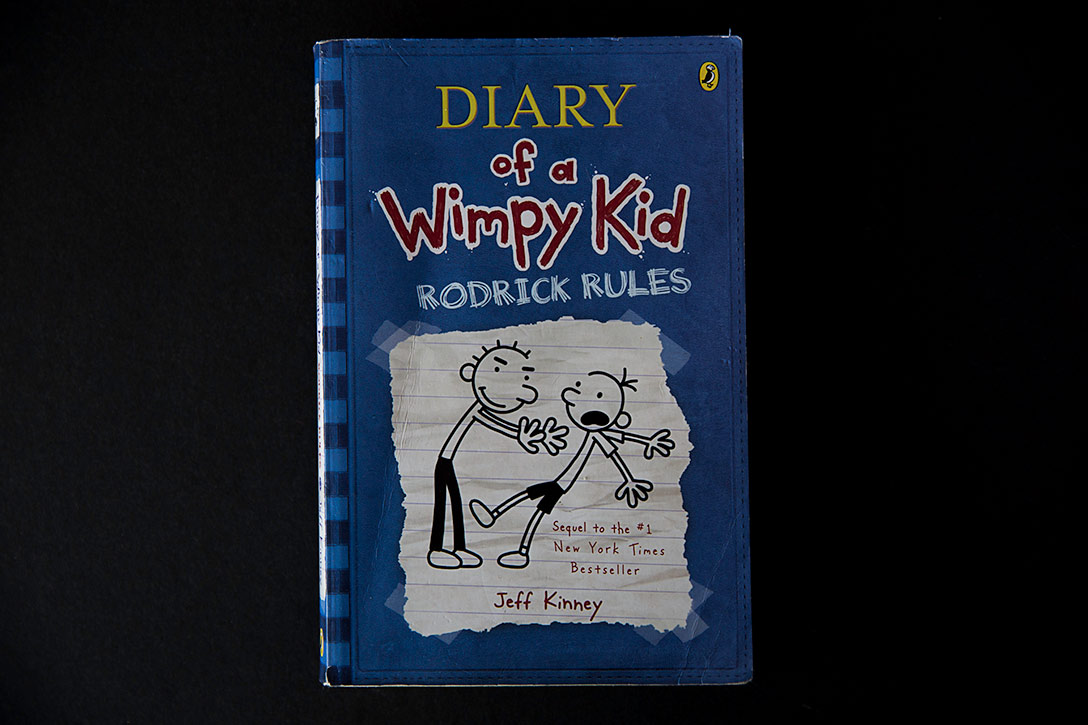Imagine me saying that headline like George Costanza.
Soon, this site will be populated with some of my “classic” posts from websites past and more new content including info on all my upcoming books.
You Know, For Kids
Imagine me saying that headline like George Costanza.
Soon, this site will be populated with some of my “classic” posts from websites past and more new content including info on all my upcoming books.
[NOTE from the future that is 2019: This is a crosspost from The Cool Kids Table, a now dormant blog I used to post at with my brothers-in-arms Ben Morse and Rickey Purdin. Though the original is still accessible, I wanted to keep a draft here as this is obviously a topic that means far too much to me personally. Below you’ll find the original post from 2008 as well as a few updated entries that ran on The CKT over the next few years. I should probably just rewrite this as an actual essay instead of a hastily drafted list of bullet points, but nah.]
It’s time for the best holiday ever invented, and since I’ve spent the past month before the annual candy binge helping out at my mother’s house, I decided to pull some photos from my Halloween archives and share some of the ridiculous lengths I’ve gone to for a rocking costume. Enjoy!
1984. A Skeleton
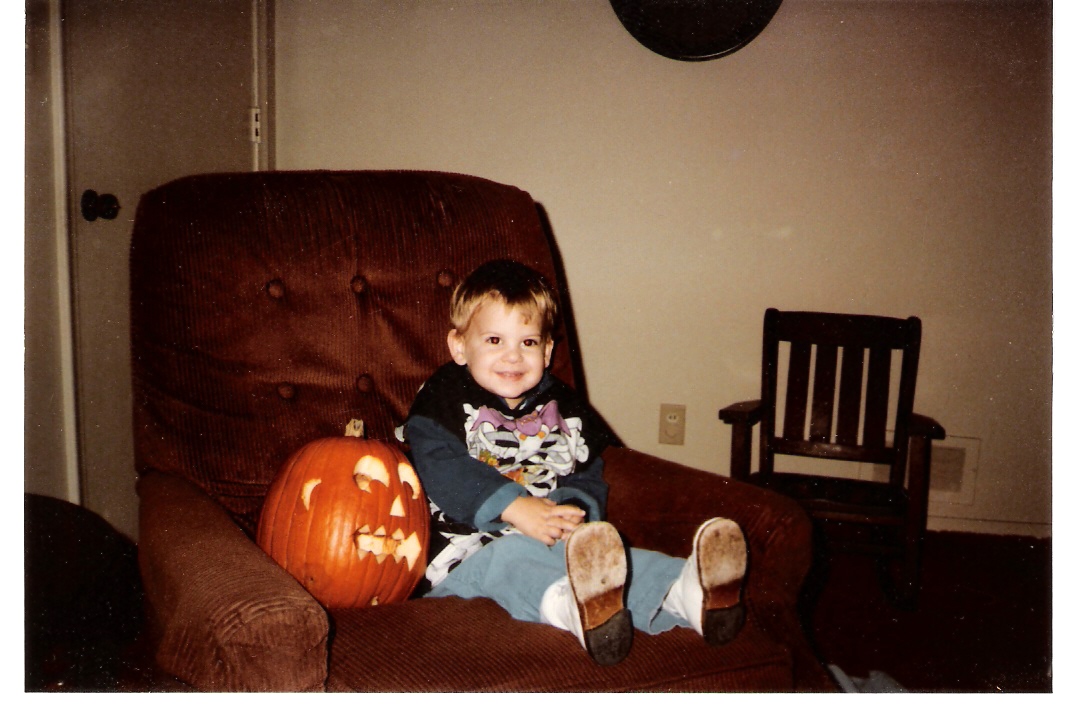
I don’t know about the rest of you people, but to me, real Halloween costumes are not bought in a store ready to wear. They’re made in part or in full by the wearer. Or in the case of my first costume (and a lot of them on this list), they’re made by the wearer’s mom.
The Skeleton overthrow I’m wearing here was sewed by my mom along with a matching pillow case-style bag that I used every year after that. They were totally boss.
1985. The First Time I Was Batman
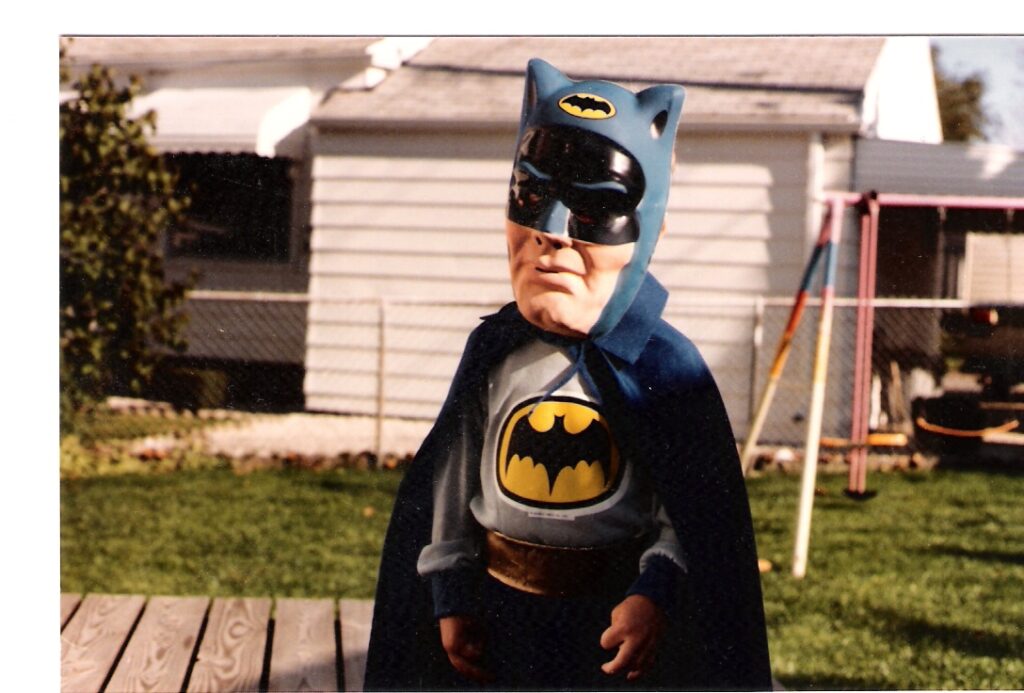
I’ve loved Batman so long I have no memory of not loving Batman, which should be pretty evident by the fact that I was dressing as him at the age of four. I’m not sure if I was routinely crashing my Super Powers Batmobile into everything in our house at every available possibility at this point, but I am pretty sure I’d already taken to watching the old Adam West show and taking it 110% seriously by then. (If you see me sometime, ask me to tell the story about when I met Adam West. It’s way too long to post here.)
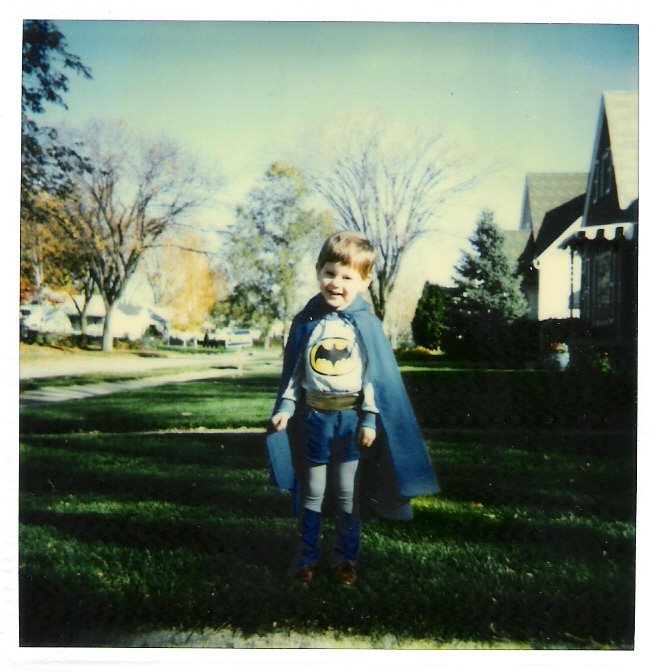
I don’t remember much else from when I was four, but I remember this costume…probably because I kept wearing the mask around the neighborhood for years after that and insisting that my friend Kyle Davis was Robin because he was shorter than me and had black hair.
1986. A Ghost
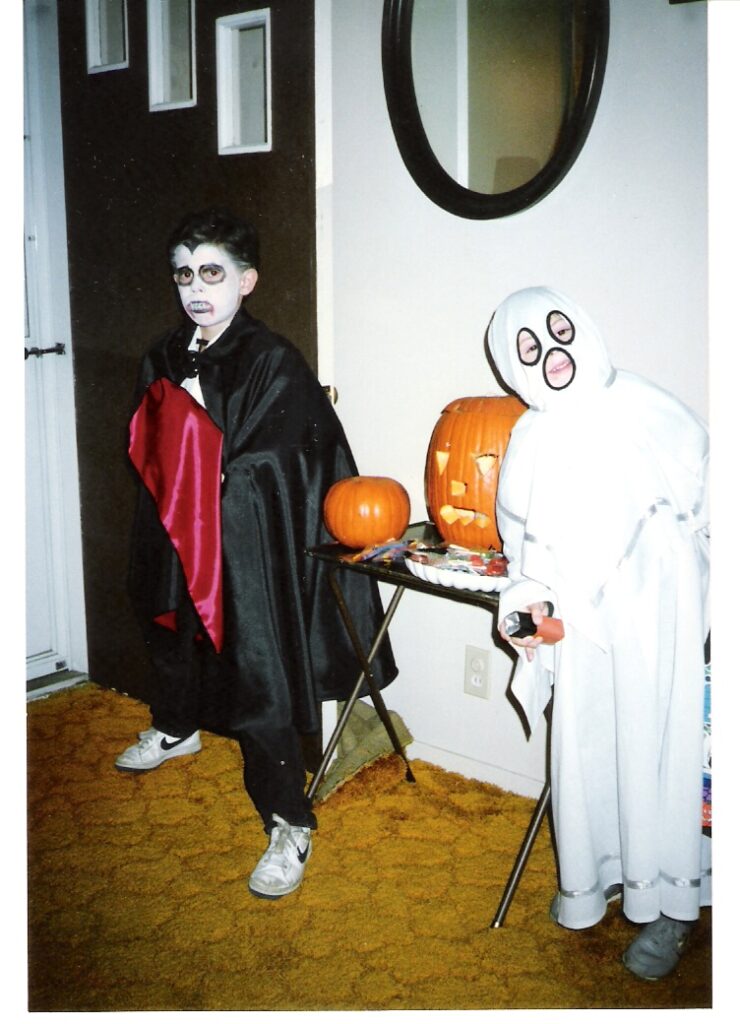
Everyone should dress up as a traditional “spooky Halloween character” at least once in their life. For me it was as a ghost, and I think the silver-lined costume mom made is still somewhere in our house. Although, both my brother Brian and I got way more mileage out of his Dracula cape and teeth, the latter of which probably gave us more shared colds than we can remember.
1987. A Policeman
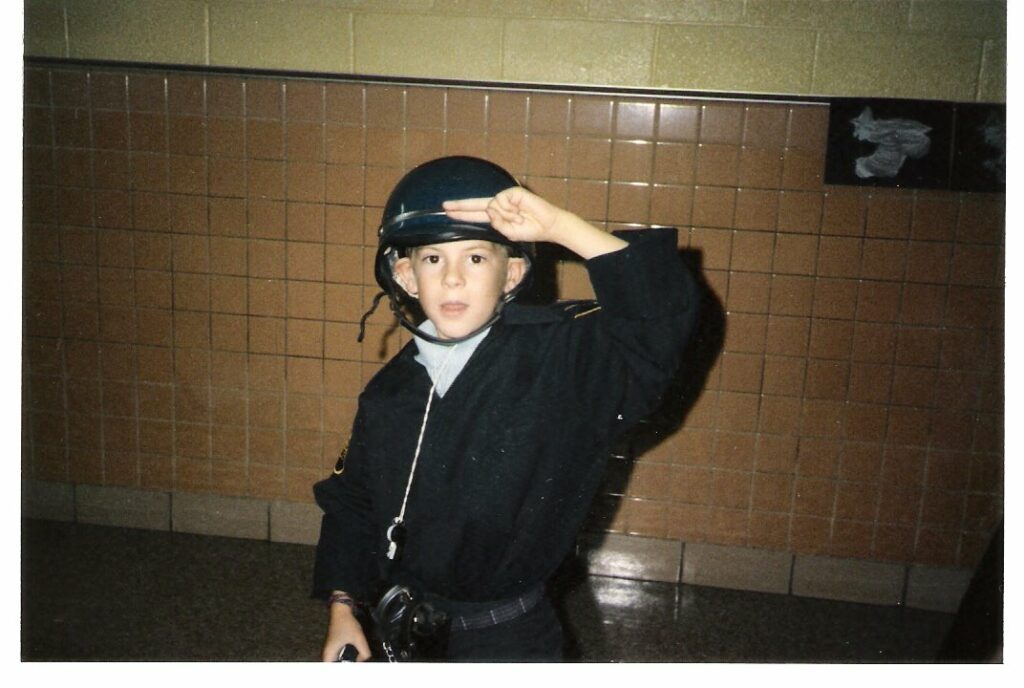
When I was a kid, my dad was a police officer in our hometown of Flint, Michigan. His tenure on the force meant that we had both a lot of crazy legendary family police stories (the time my aunt maced herself, the time dad’s partner accidentally shot a hole through our bathroom wall) and a lot of old police equipment in our garage, including the real gun belt I’m rocking here. Also, that odd looking helmet comes from my dad’s short stint riding with Flint’s mounted division (Yes, Flint, Michigan employs police on horseback).
1988. Darth Vader
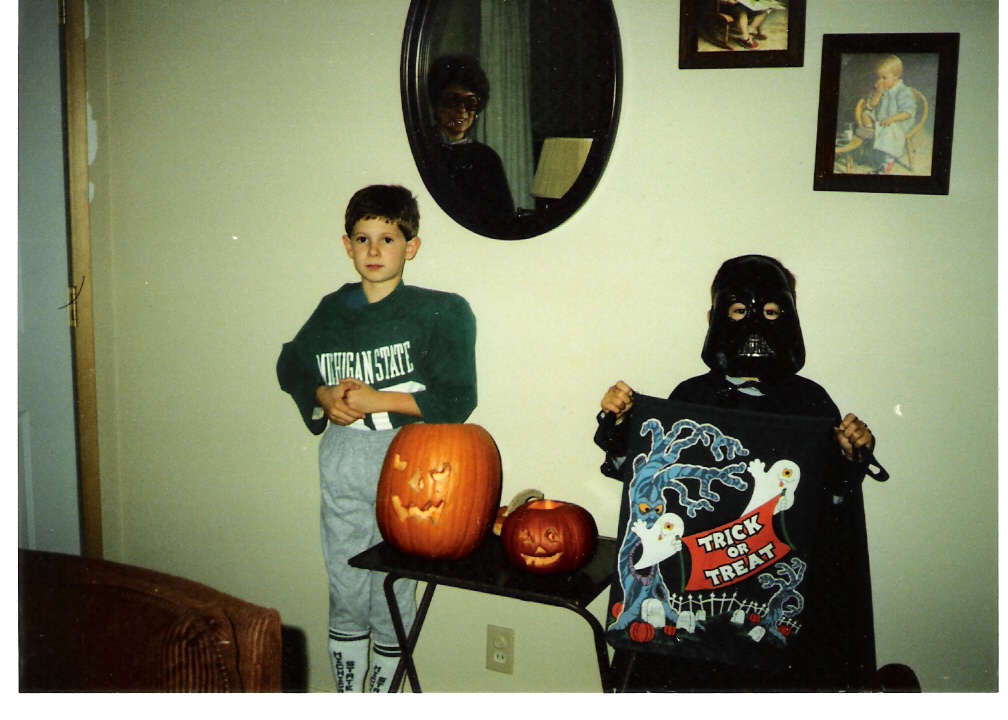
When you’re a little brother, it’s a fact of life that most of your clothing comes in the form of things your older brother has grown out of. Sometimes this happens with Halloween costumes too, including this Darth Vader getup. I seriously didn’t mind, though, as the costume was super dope. The front piece breathing apparatus my mom made by wrapping a bunch of material around one of those single serving Frosted Flakes boxes with buttons sewn on the front. Pretty slick, mom.
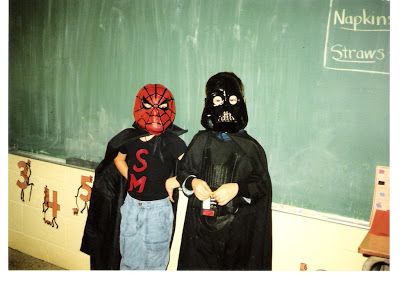
I honestly think the above pic is one of my brother in the costume from the year before, but for reals, how could I not include a picture of VAMPIRE SPIDER-MAN?!?!?
1989. The Second Time I Was Batman
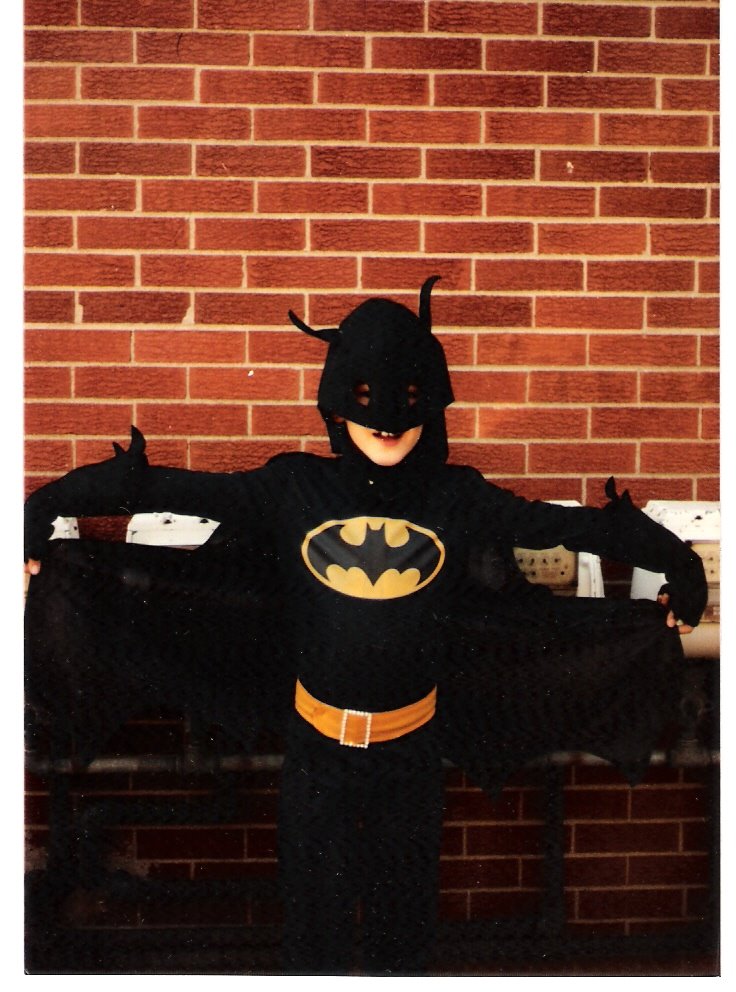
When Tim Burton’s “Batman” film came out in 1989, I spent the summer collecting every toy, trading card, magazine, glow-in-the-dark Frisbee, mail away bank from a cereal box and Prince “Batdance” cassette single imaginable. Was there any doubt that I’d dress as the black-clad version of the Dark Knight that Halloween? No. But who could have guessed I’d look so bad ass.
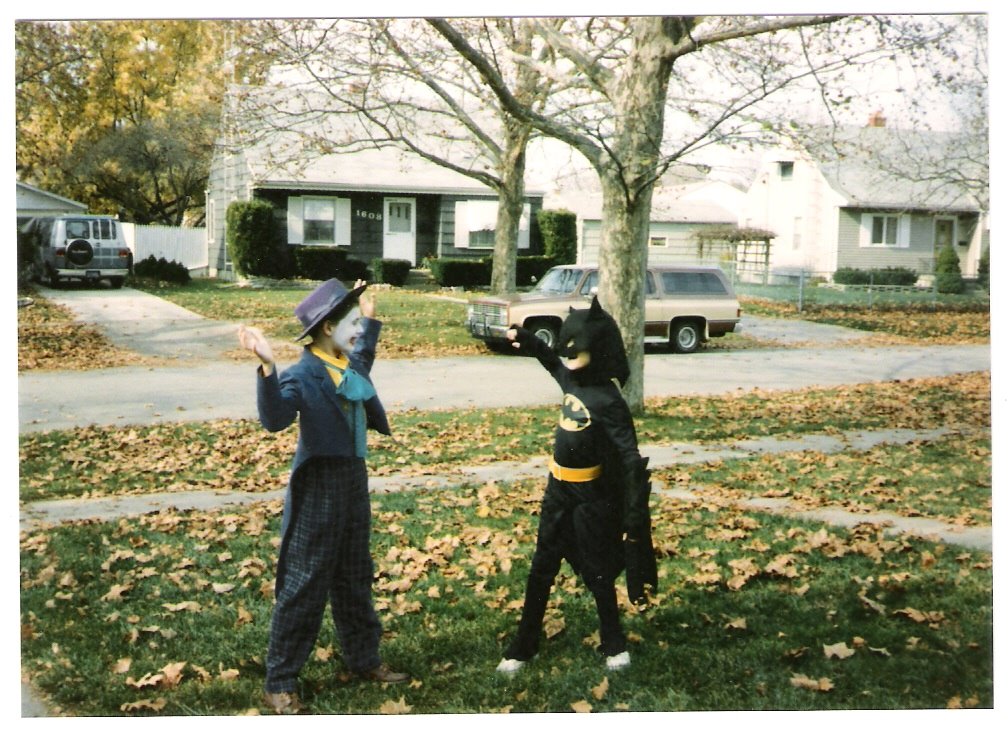
In the most telling of our costume pairings, Brian (my real life archnemesis) dressed as the Joker (my fake Halloween archnemesis). We’re totally cool now. I think that I wore that Batman costume every day for a week straight…possibly without showering (less gross when you’re eight).
1990. Dick Tracy
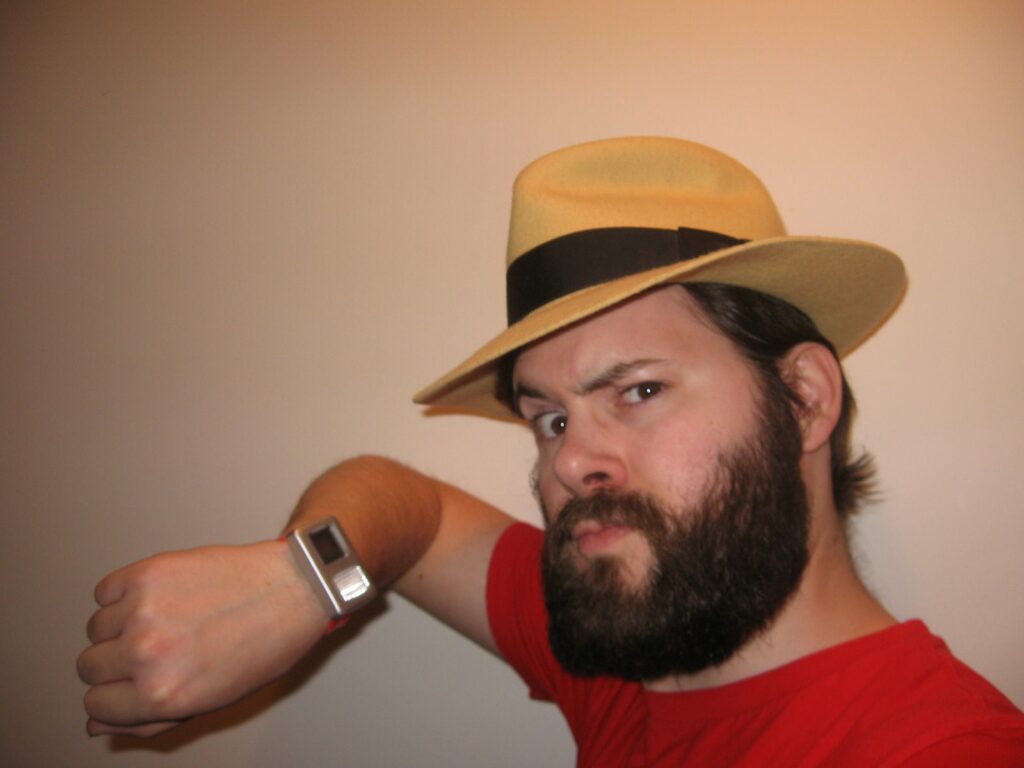
Unfortunately, I was unable to find any of the pictures of me in the totally awesome Dick Tracy trench coat mom sewed for me out of yellow corduroy which we still have. Fortunately, I was able to find the official Dick Tracy fedora and signal watch I wore to lend authenticity to the ensemble. That watch was awesome because it both told the time and lit up when I decided to call into headquarters Warren Beatty style.
1991. Moon Knight
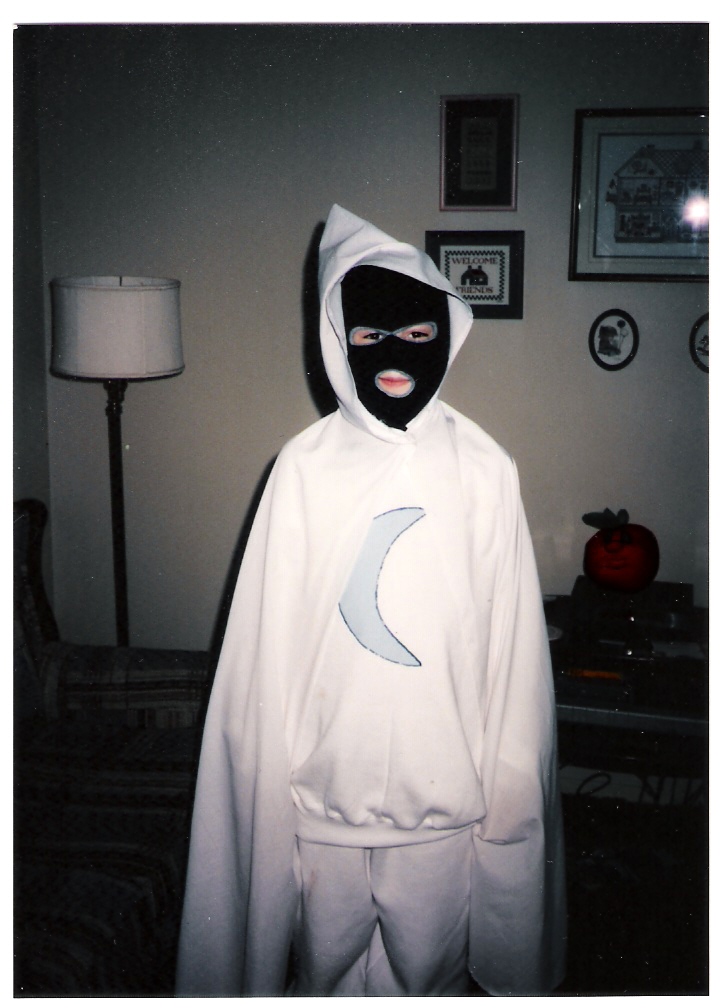
Unless someone presents evidence to the contrary, I’m going to go ahead an assume that I am the only 4th Grader in the history of America to dress up as Doug Moench, Don Perlin and Bill Sienkiewicz’s werewolf-fighting, billionaire, schizophrenic superhero Moon Knight. And you know what? I’m totally cool with that.
1992. Cyclops
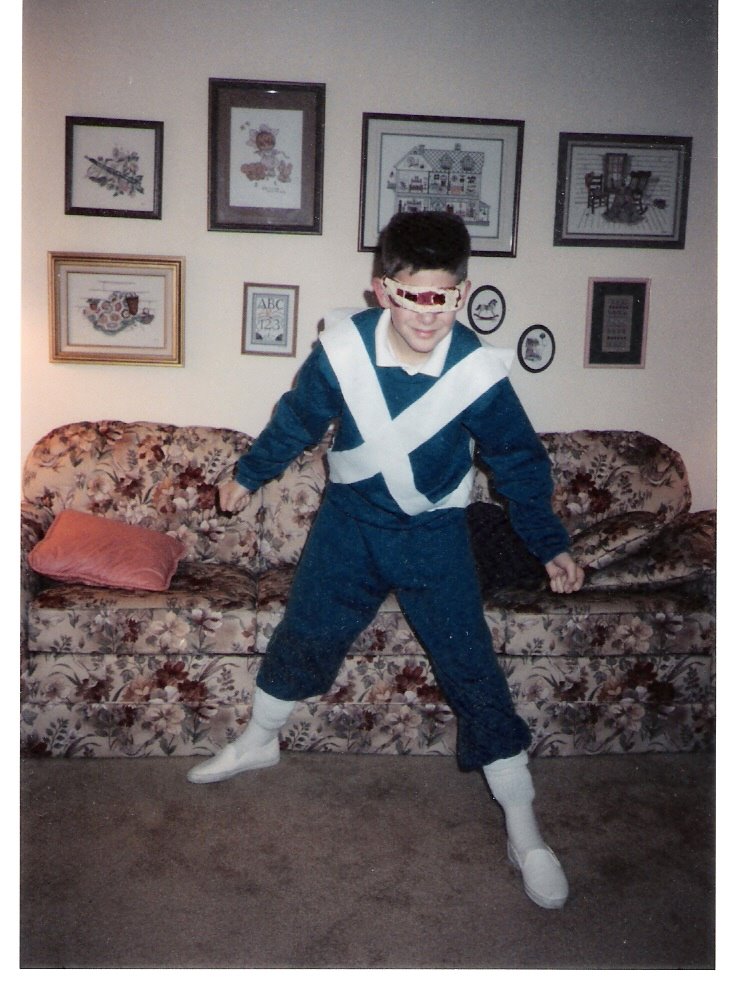
In the summer of 1992, my family moved to the suburb town of Grand Blanc, making me change schools for the first time. In retrospect, I probably did myself no favors in terms of fighting the “weird new kid who likes comic books way too much” stereotype by dressing up as Cyclops and answering questions as to who I was by saying, “I’m Cyclops. I used to be in the X-Men, but now I lead X-Factor.” But how could I resist dressing up like this sweet Marvel Universe trading card by Ron Lim?
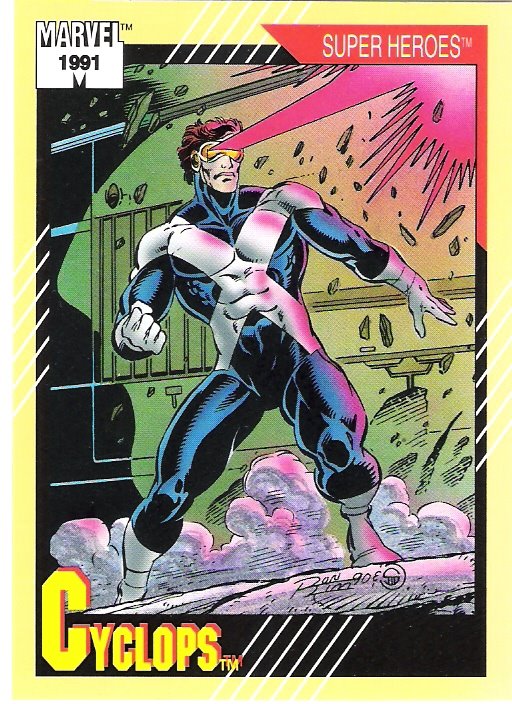
I made the visor myself by cutting out the red lenses from two pair of 3D glasses and affixing them to a felt headband by way of thread and an insane amount of hot glue gun work. I recall walking down the hallway of my new school and having an older kid ask aloud, “Did he seriously make that mask himself?” and thinking, “Uh…yeah! Because I wouldn’t really be Cyclops without a ruby quartz visor, you loser!”
1993. Clark Kent
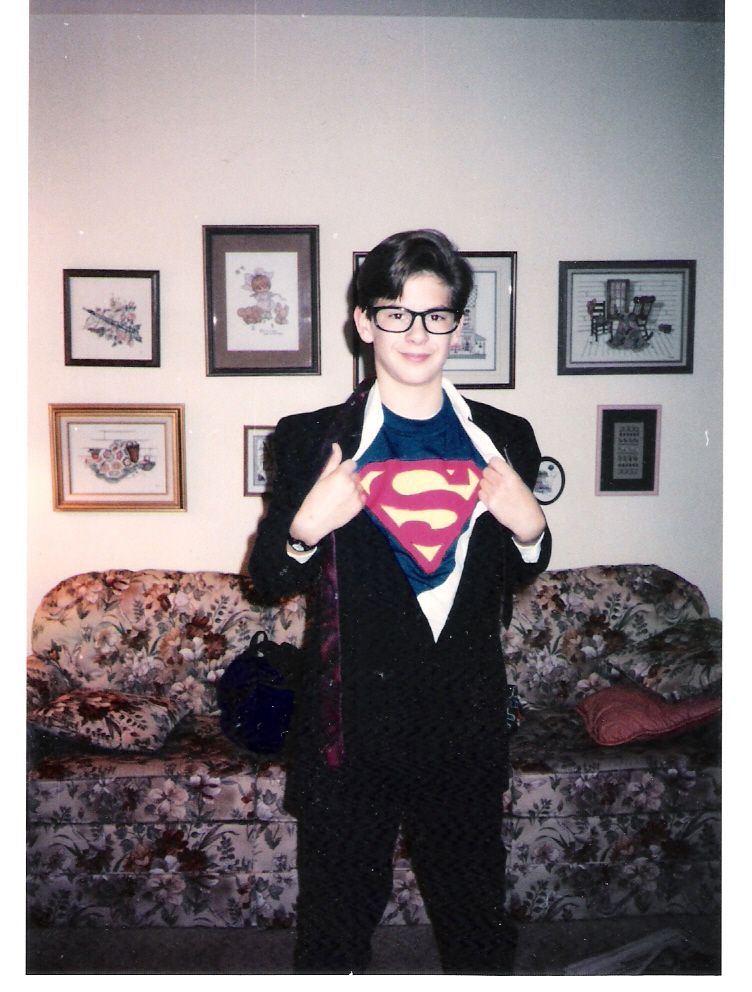
Believe it or not, there was a time pretty recently in America where cheap T-shirts with Superman’s S-Shield were not sold at every kiosk in the local mall, so when “Lois & Clark: The New Adventures of Superman” debuted, combining my twin nerd loves of comic book superheroes and romantic comedies, I had to have my saintly grandmother put together this shirt by giving her a Dan Jurgens comicto use as a model.
1994 – 1997. The Lost Years
Two things happened between the time I was in 6th Grade and my Sophomore year of high school: the Phegley family kind of stopped taking photos of any kind and caring about how cool your Halloween costume was became pretty low on the priority list for my peer group (I think puberty may have something to do with the latter). End result in terms of this essay? I have no photos or really a lot of recollection of costumes from that period. I’m pretty sure I did something comic related most of the time and know that in the 8th Grade I was The Shadow because of that not-so-great Alec Baldwin movie, but beyond that…I got nothing. Luckily, things started looking up in high school when I met a group of friends who got back into the costume game for an annual Halloween party at my friend Lauren’s house, leading to…
1998. Jay & Silent Bob
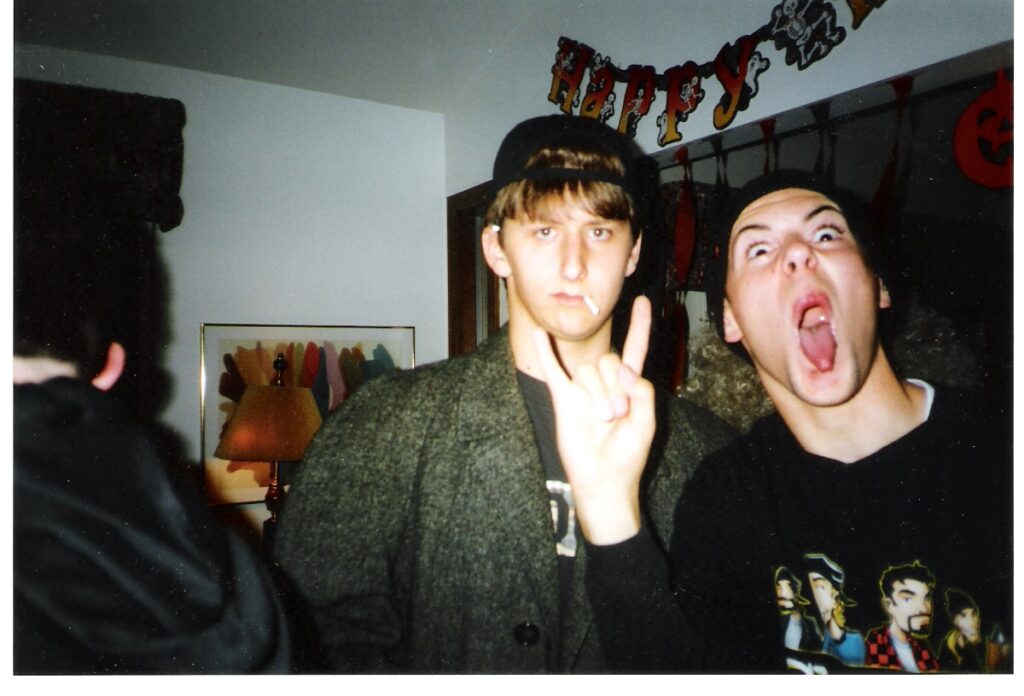
I know this costume choice may be perceived as a point against me for some of you, but you know what? When I was 17, the only movies Kevin Smith had made were “Clerks,” “Mallrats,” and “Chasing Amy” so Cullen Brown and I pretty much figured he could do no wrong. Plus, it allowed me to swear in front of adults and not get yelled at because I was “in character.”
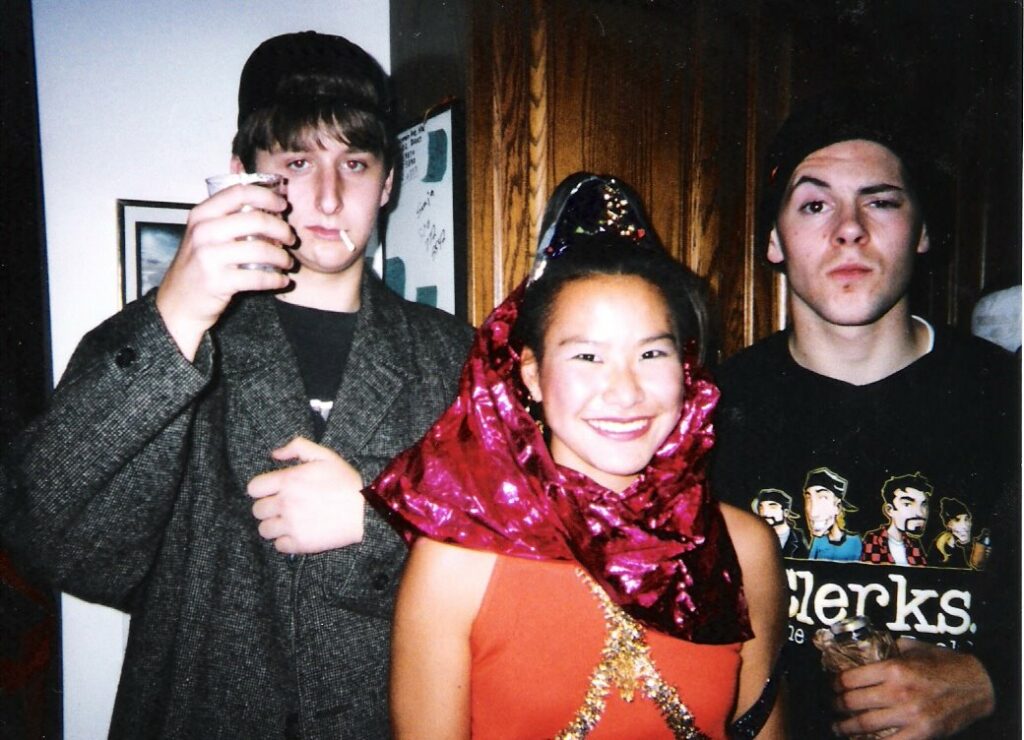
Note Cullen’s candy cigarettes and my brown bagged bottle of lemonade (we were good kids) and my Clerks comic book T-shirt by the always link-worthy Jim Mahfood.
1999. Starman
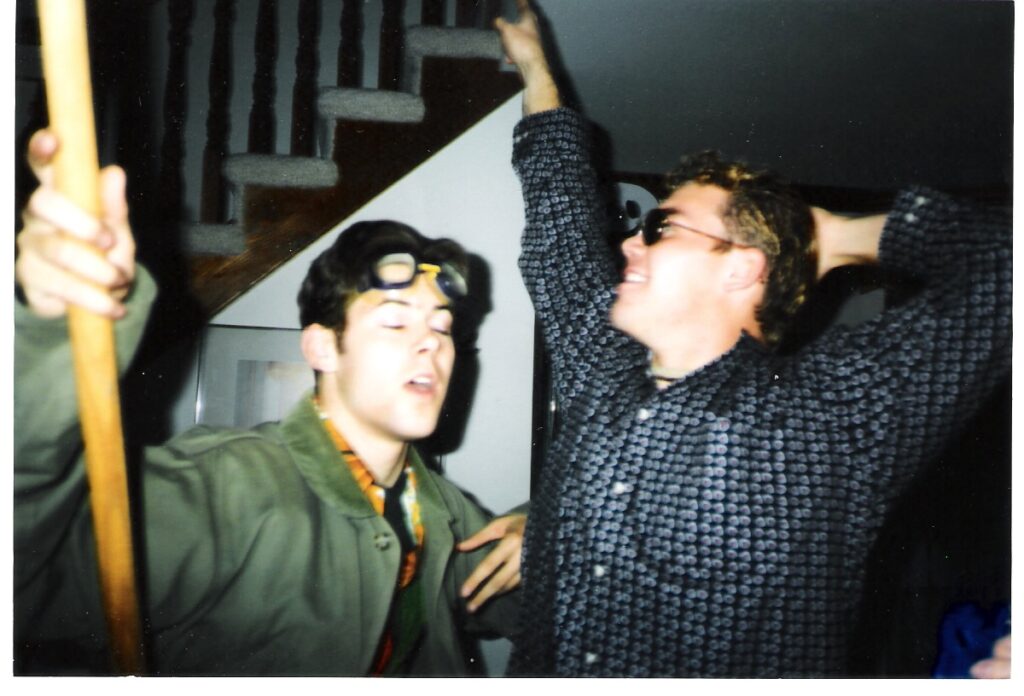
James Robinson’s Starman comic is still my favorite monthly series of all time, so I had no qualms about going to a party with swim goggles on my head, an ugly Hawaiin shirt (which I actually wore A LOT back then) and a “cosmic rod” I made with half an old hiking stick with a yellow ball from the MacDonald’s ball pit glued on the end. What you can’t see in this picture of me dancing poorly with my buddy Kegmeister (who apparently went as some sleazy greaseball) is that I had nerd cred on my side that night as my costume included DC’s official Starman tin badge that I’d bought at a con that summer. Represent.
2000. Shaggy & Velma
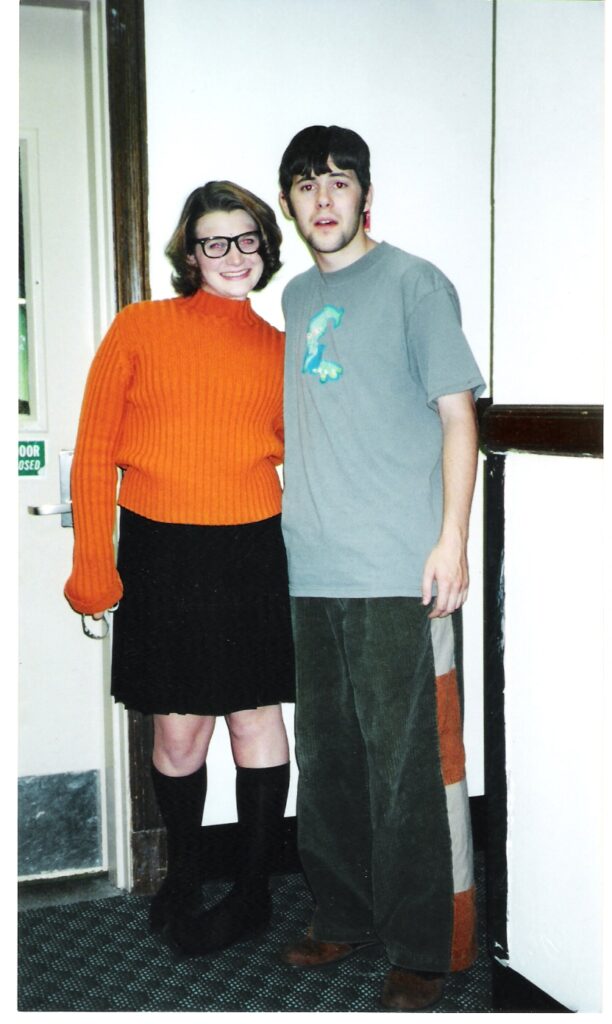
My Freshman year of college, my girlfriend Jami and I had a whole scheme with a bunch of other kids in our dorms to go out for Halloween parties dressed as the gang from Scooby-Doo. Unfortunately, no one else came through, but screw those kids…we looked hot anyway. But you know…without Jami, my costume isn’t much of a costume as it consisted of a Phish T-shirt and a pair of hippie pants my brother sewed himself and then gave to me when he joined the army. I would’ve worn that anyway in college.
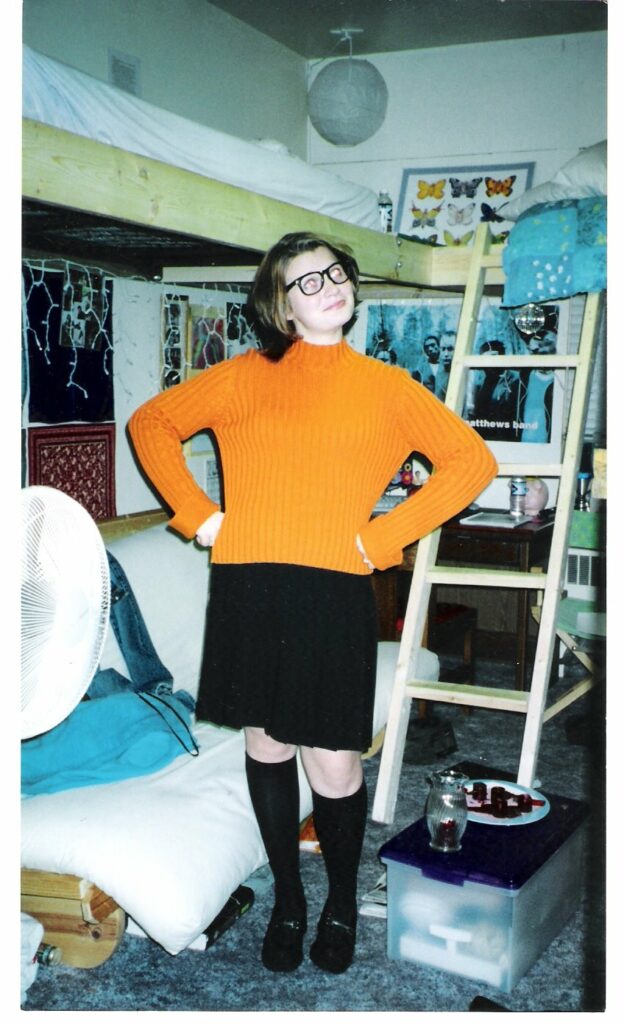
Jinkies!
2001. Tommy Chong & Josie
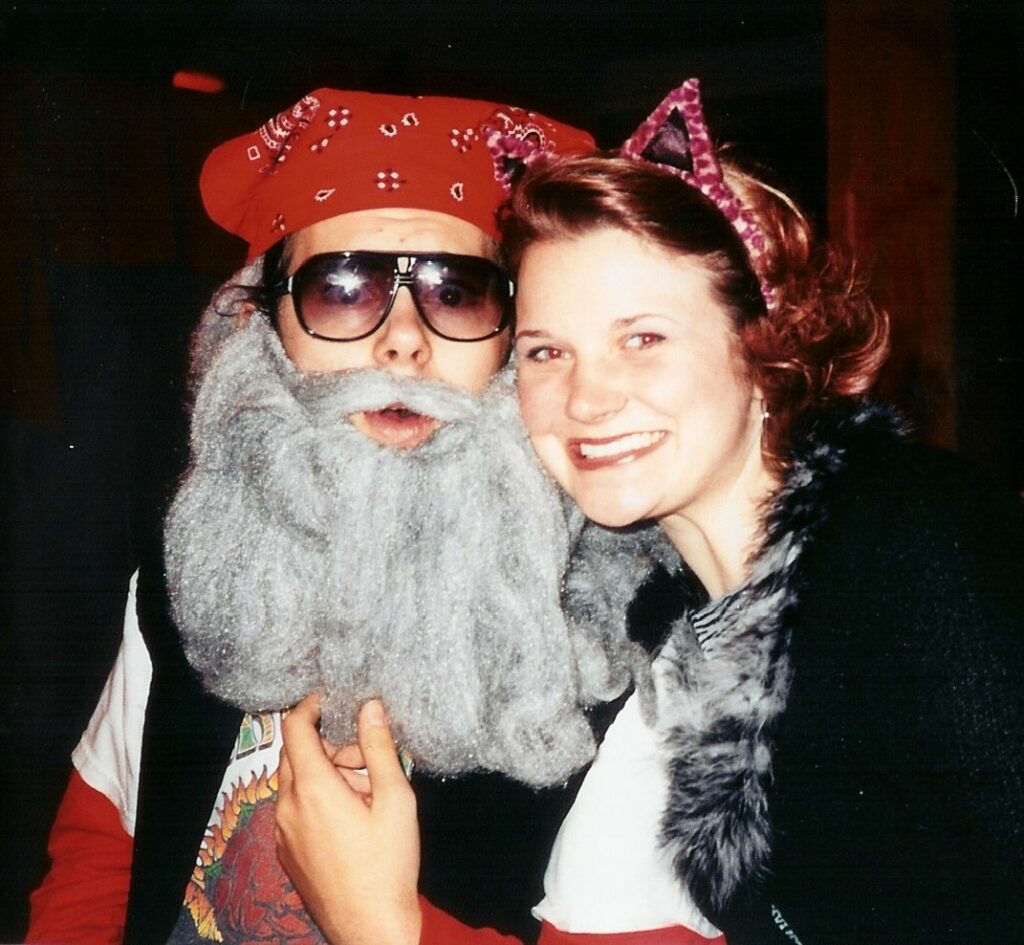
Although I couldn’t find a photo of it, Sophomore year of college my roommate Justin and I did an arguably ill-advised costume team-up going as Cheech and Chong. On the up swing, Jami and her roommates pulled off a rad Josie & the Pussycats trio inspired by the totally underrated movie by Deborah Kaplan and Harry Elfont.
2002. Green Lantern & Hello Kitty
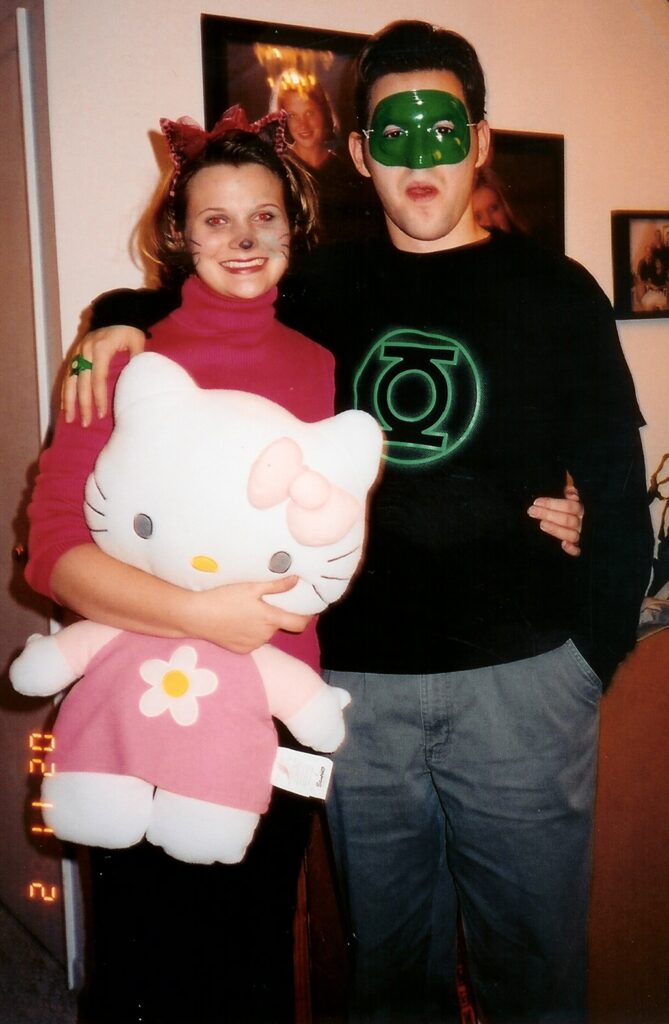
I know nothing about the costume screams it, but in my mind I was always Kyle Rayner and not Hal Jordan, which is funny as the ring I’m wearing is actually autographed by Alan Scott creator Mart Nodell. If you understand anything about that last sentence, you’re a nerd.
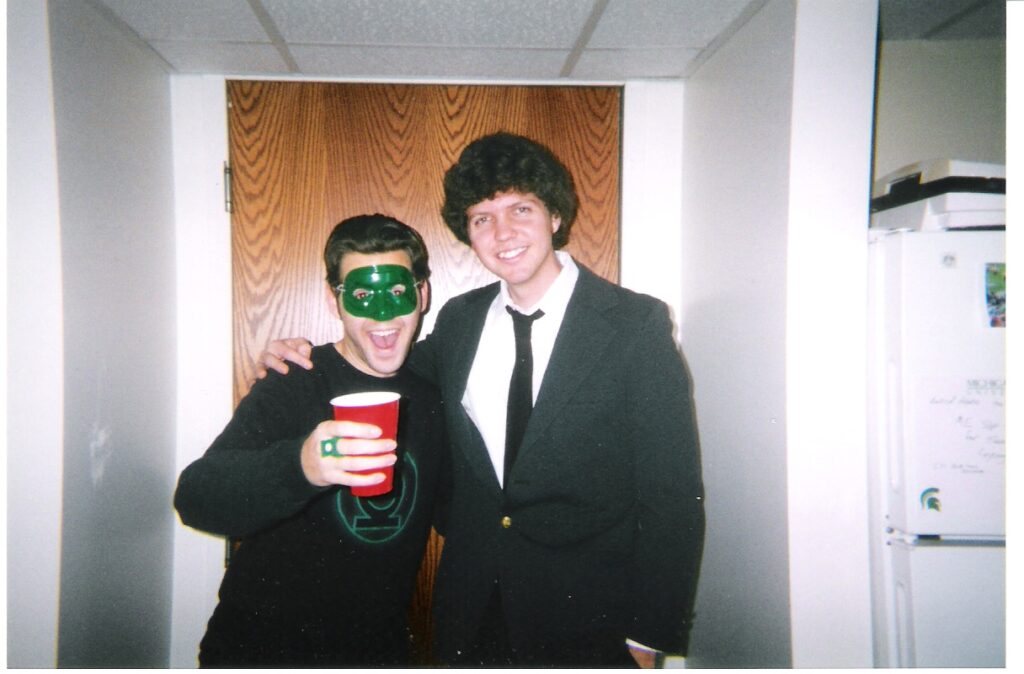
Above is a picture of me and a guy dressed like “Piano Man” era Billy Joel.
2003. The Third Time I Was Batman
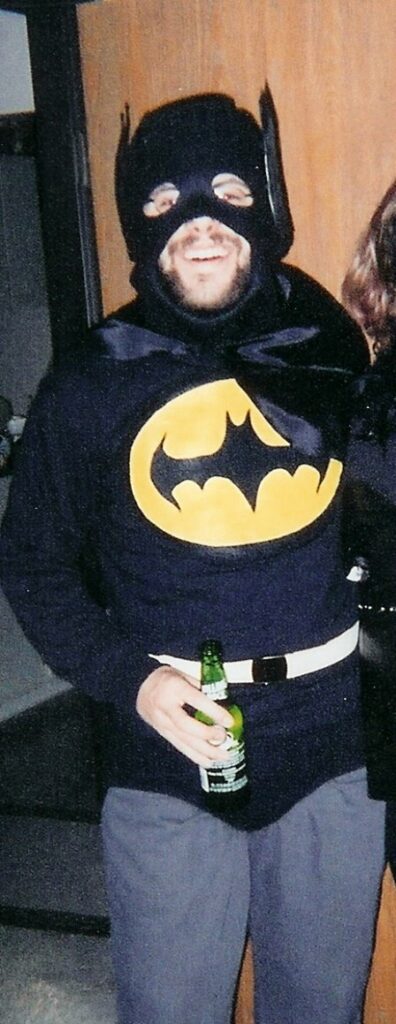
Jami and I returned to the couples theme Senior year as Batman and Catwoman. I know what you’re thinking, and you’re right…Batman does not wear glasses under his cowl or have a beard. But you know what? He does wear his underpants outside his regular pants, so you’ve got to give me some credit there, right?
2004 – 2007. Green Hornet, I guess?
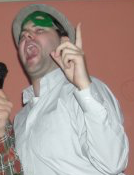
During these years, my few meager attempts at Halloween costumes have been forgettable and largely unphotographed, but my most frequent thrown together costume was of famed radio superhero The Green Hornet. This was usually pulled off by recycling my Green Lantern mask and a fedora I bought for $5 in Chinatown. I think I dressed as Captain America once too, for a performance that would best be left as a mystery to time.
2008. Flint & Lady Jaye
Jami and I had a little too much fun dressing up as G.I. Joe’s cutest couple that year. But aside from thanking my older brother for the loan of the beret that I’m pretty sure has been to Iraq and back, I thought I’d offer these without comment.
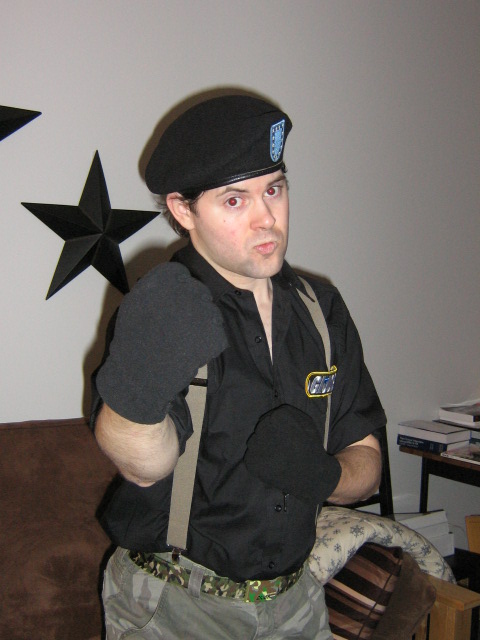
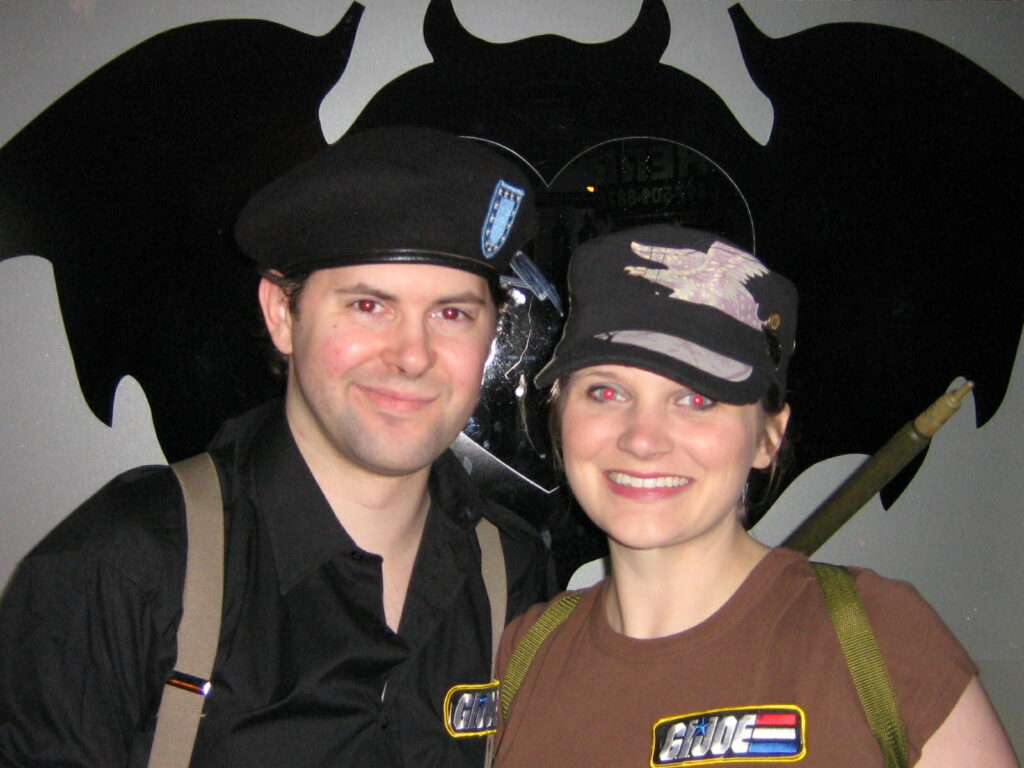
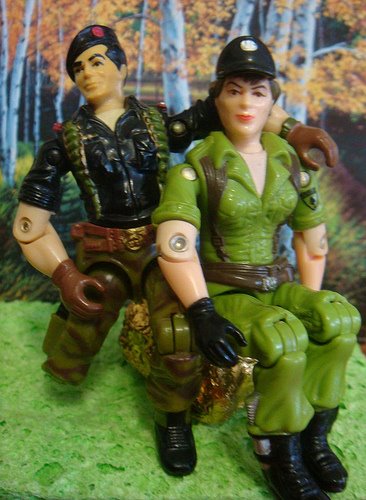
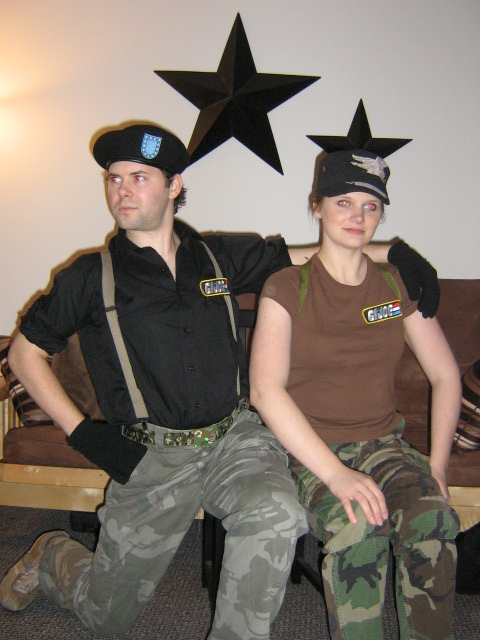
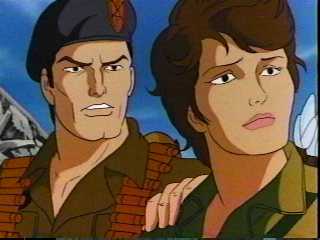
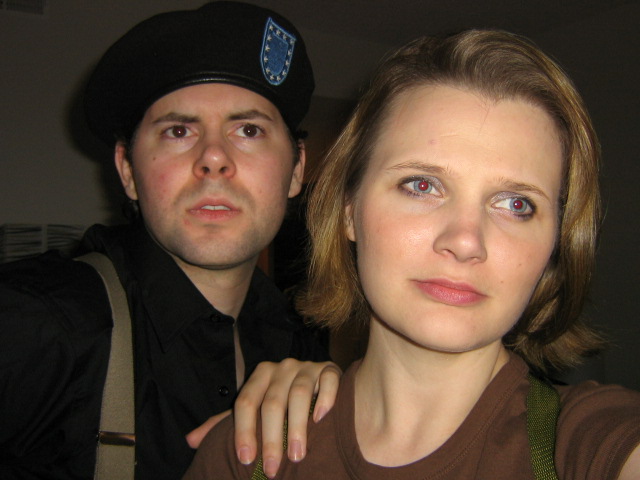
2009. Chuck Bass & Blair Waldorf
Jami and I followed up last year’s experiment in couple’s comic bookery by dressing up as the meanest power couple on trashy TV: Chuck Bass & Blair Waldorf from “Gossip Girl.” Since we kept the party at our place, I didn’t quite get to pull off my planned move of answering everyone who asked what I was supposed to be with “I’m Chuck Bass” only to have them stare at me befuddled, but I got to do it a few times.
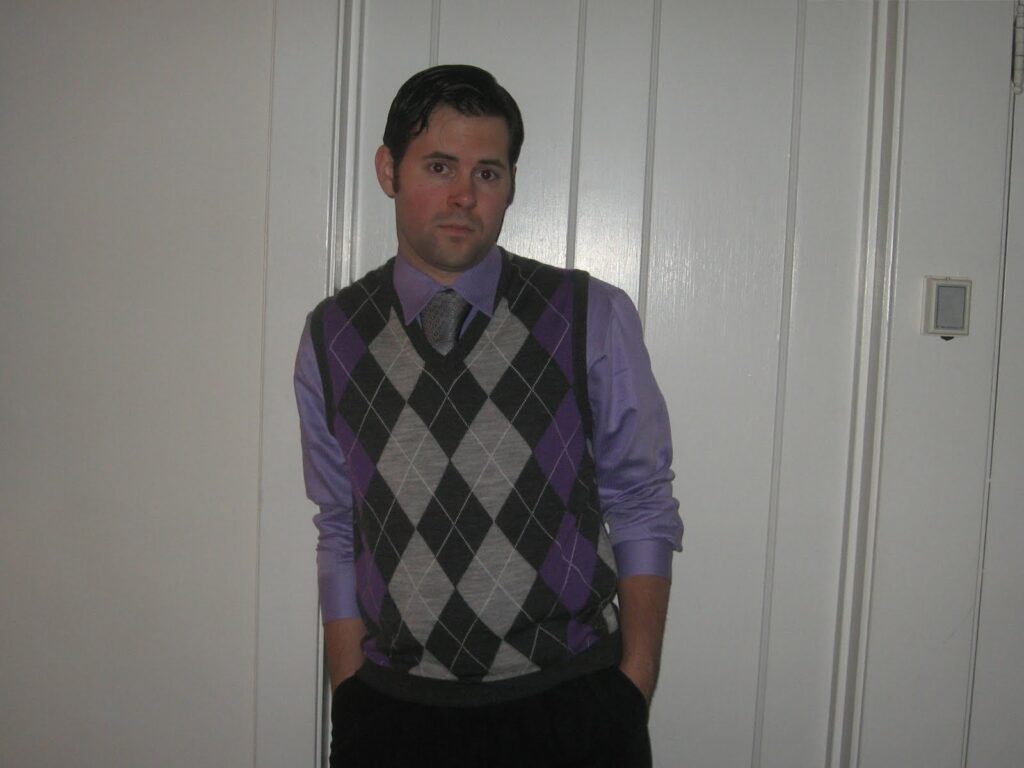
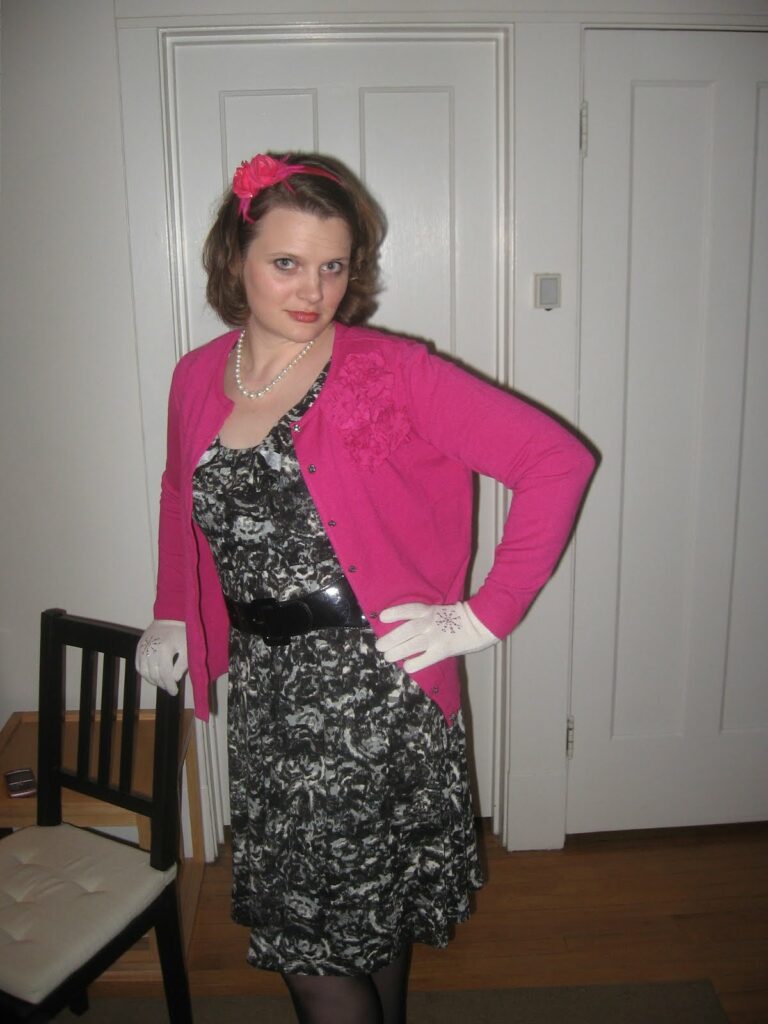
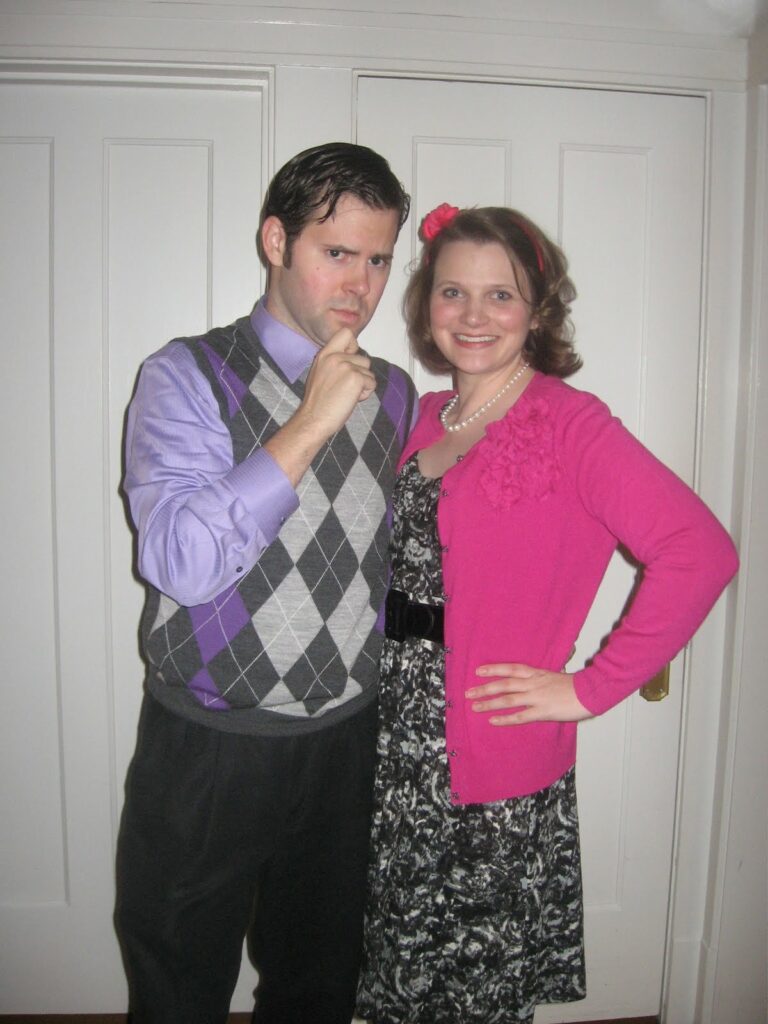
2010. Scott Pilgrim & Ramona Flowers
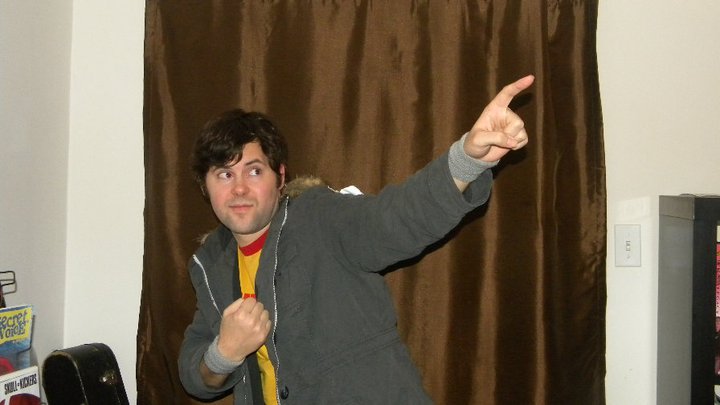
Squeezing one last drop out of the year of Scott Pilgrim, I dressed up as Bryan Lee O’Malley’s hero with an eye towards seeing how many people actually knew who I was dressed as (turns out…about 10!).

Is it just me, or is like 83% of the fun of Scott Pilgrim cosplay the act of poorly recreating poses from the book’s covers?
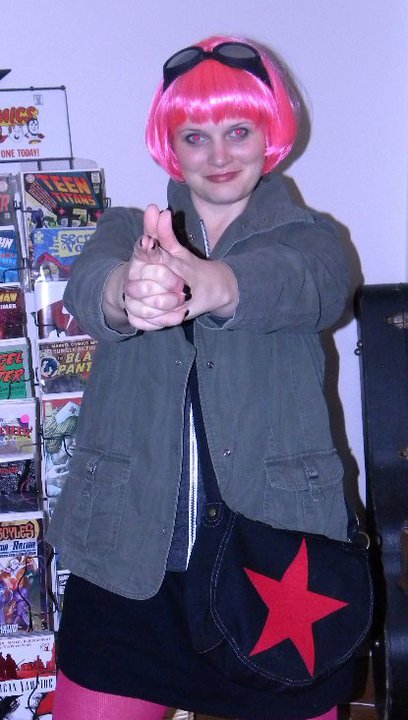
Jami ended up going as Ramona Flowers, which it turns out is a much more recognizable look for party people to latch onto. She was a total trooper, even though she was ready to burn that wig by night’s end.
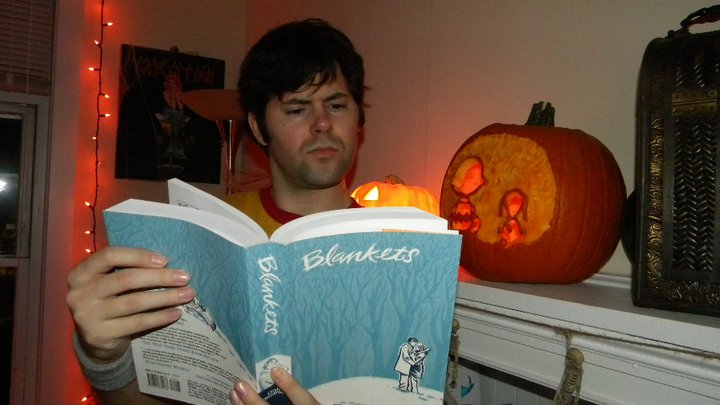
There weren’t a ton of other comics folks on the prowl at the three parties we hit up on Friday night, but one of them did have a lone copy of Blankets sitting next to a “Peanuts” Jack-O-Lantern. Instant photo op!
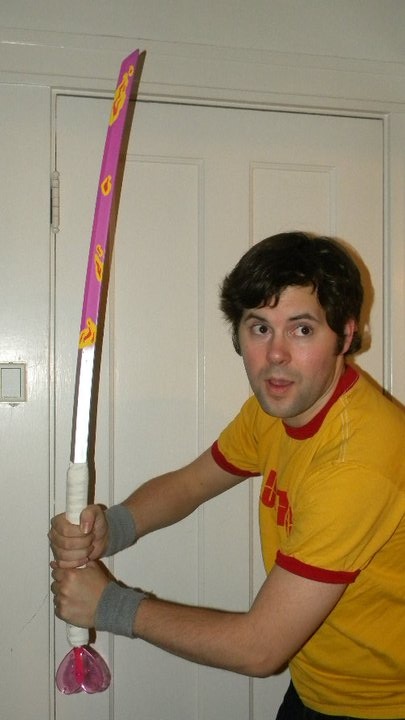
I took more than a few pics of the sword because it cost about $40 to make, and unlike the Plumtree t-shirt and the six XL women’s winter coat from Old Navy, I’m never going to have any use for it ever again. The nice thing about the sword though is that when people did recognize who I was, they’d instantly go, “Holy shit! You earned the Power of Love!”

Our gimmick for the night was that whenever someone recognized who we were, we gave them chocolate coins. As you can tell, we had quite a few left over at the end of the evening.
2011. Ned and Cat Stark
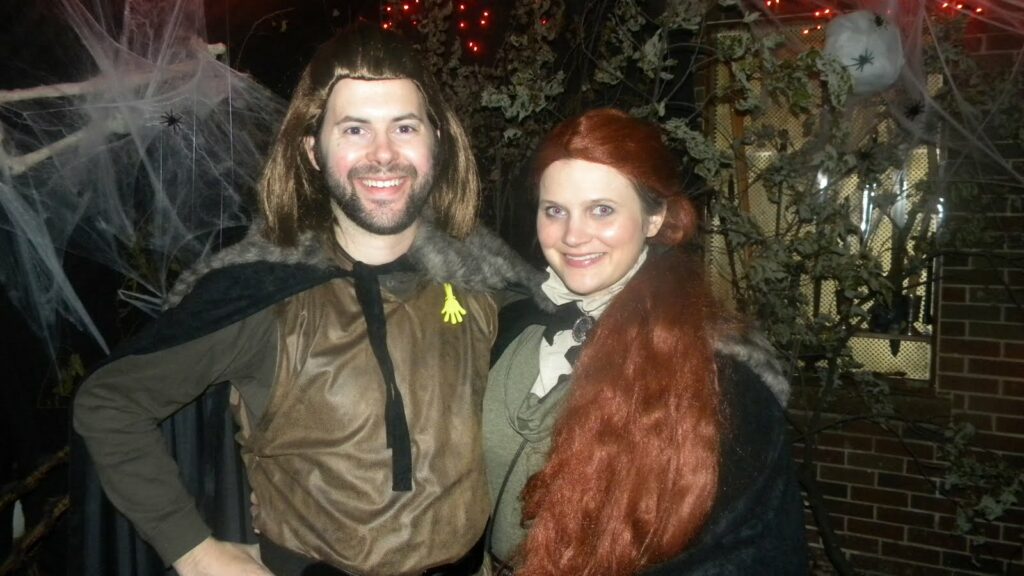
This year I think we took things as far as we could in assembling pieces to be Ned and Cat Stark from “Game of Thrones.” The actual choice for costume came late in the game, but once Jami decided this was the one, she also decided to make a lot of the costumes herself on a sewing machine she got last Christmas.
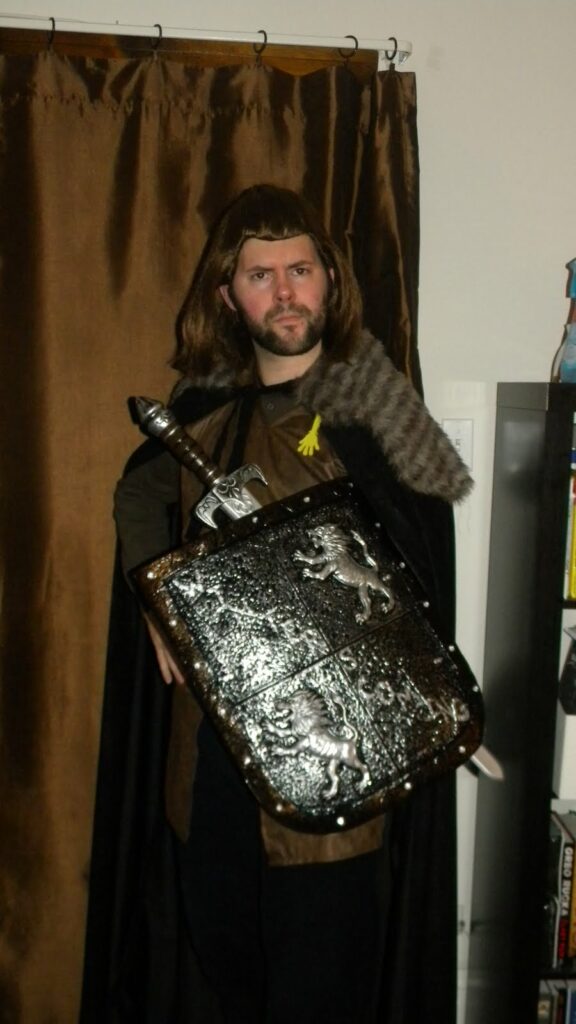
Baby did a good job too! The capes and my tunic and other bits and bobs were put together by her, and she painted up my shield to be a bit more Winterfell-ish (you can’t read it in his pic, but it says “Winter Is Coming” across the front). My main contribution was super-gluing the world’s cheapest Hand of the King broach. More on that in a minute.
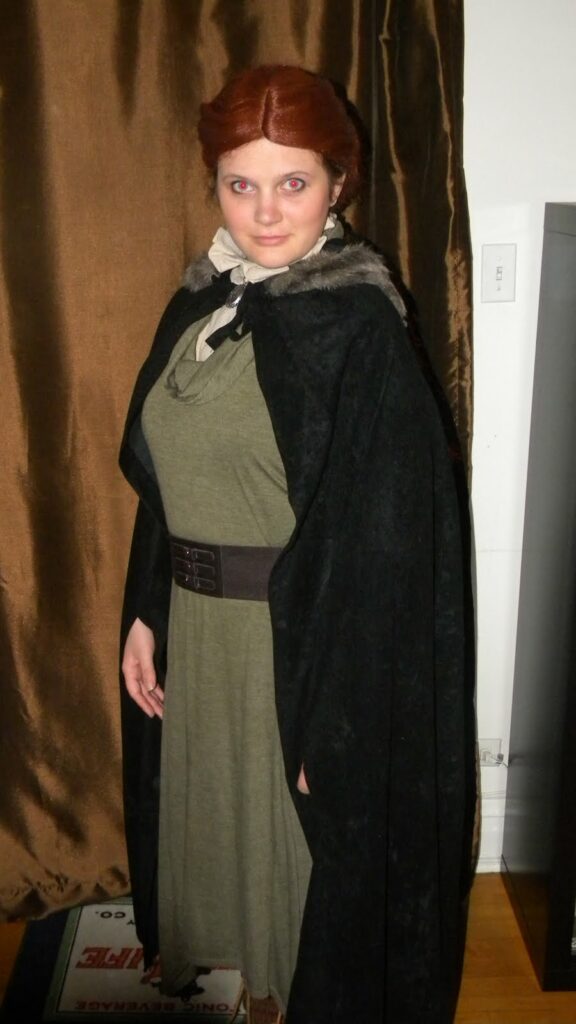
Jami was a little bummed we couldn’t find some suitable fish flair into her costume, but she pulled Cat off pretty great (that wig was super long and out of control!). Overall, our goal at Halloween parties has become tallying how many people actually know what we’re supposed to be. This year about ten folks knew, many of them from the Song of Ice And Fire books and NOT the TV show. Props.
2012. Katniss & Peta
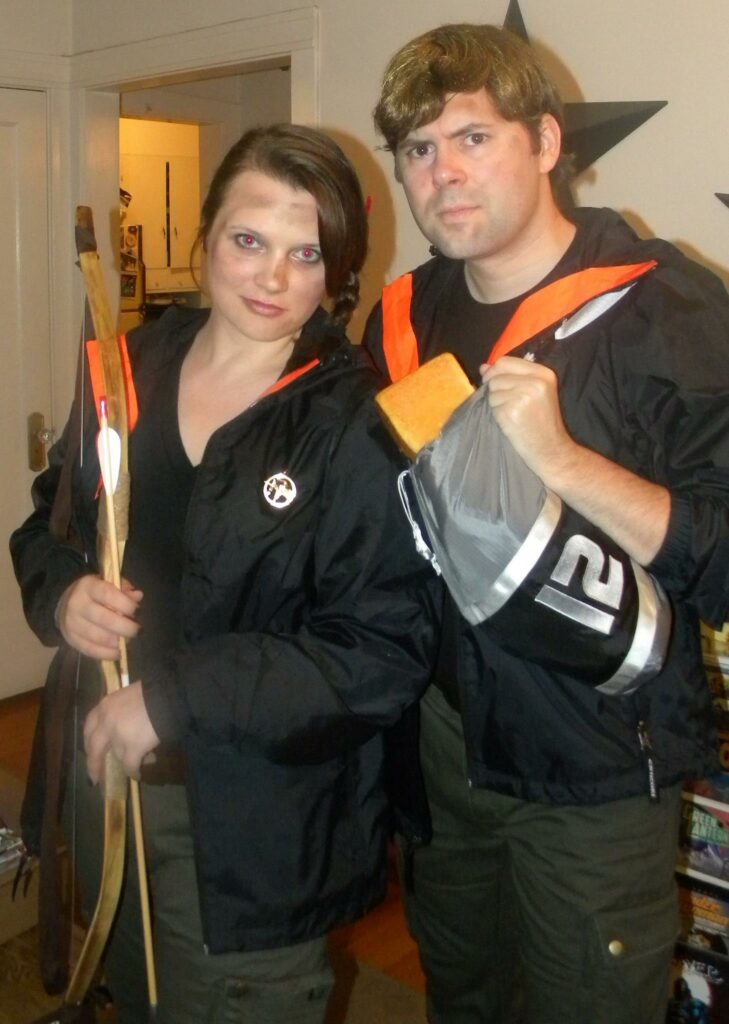
Perhaps the only time in history that Jami has gotten way more into a piece of nerdy pop culture than me was when The Hunger Games had hit huge in advance of the first movie. She burned through the books and took point on what I still think is the best costume in our long run.
Since then, we’ve become parents and have transferred all our costuming energy onto the child. Maybe someday we’ll make a dramatic return…
[NOTE from the future that is 2019: This is one of a number of posts I’ve migrated over to the site from my internet past that’s been scrubbed in one way or another. This particular post is a pair of interviews published over 11 years ago on the “Indie Jones” blog I co-wrote during my first job at Wizard Magazine. Both of these interviews with Scud creator Rob Schrab ran in HIGHLY abbreviated form in Wizard, but I really wanted to have the whole discussion out there in honor of the book. I guess I still do.]
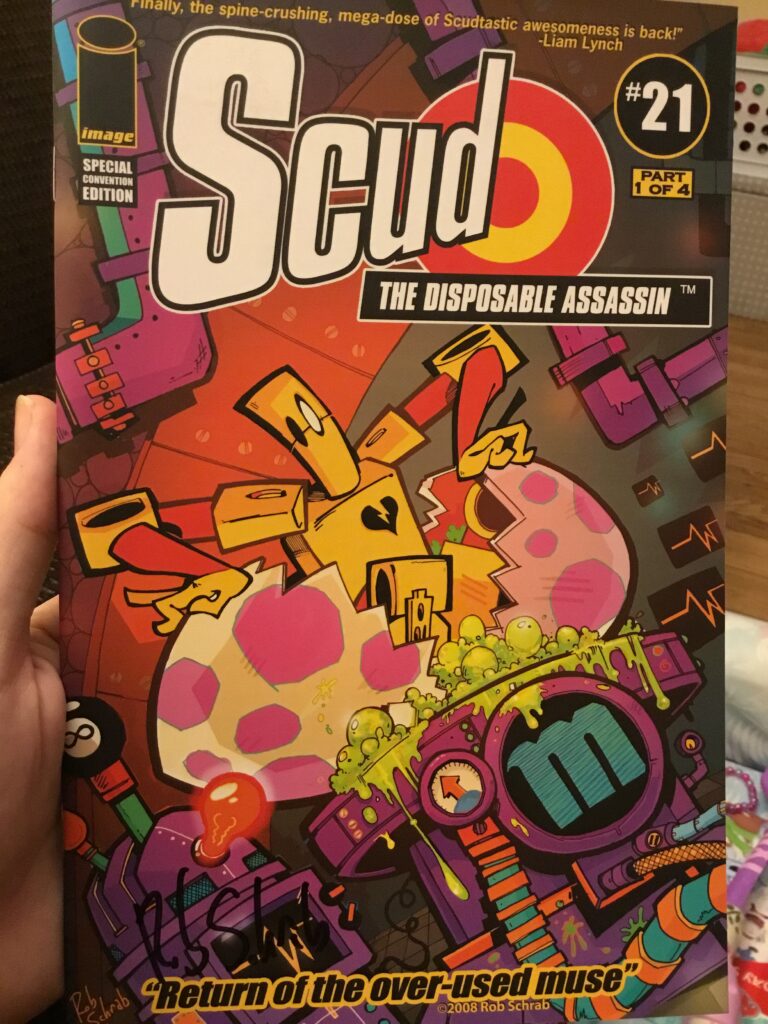
This past Wednesday, Middle School Kiel’s favorite comic book finally came to an end when Image Comics published Scud: The Disposable Assassin #24. With a completely subjective mindset, I have to say that it was awesome, and I highly recommend it to anyone who ever loved the series when creator Rob Schrab originally self-published it in the mid ’90s (if you’re unfamiliar, wait a few more weeks until the giant trade of the whole series hits on June 25th).
I don’t know if I could sum up in words how much I love this damn comic, and I don’t think anyone would care to read that anyway. But I thought maybe someone might want to read the two interviews I did with Schrab during the production of the final four issues (one was for the old site, the other for the mag’s Edge section), so here they are. The first interview took place just after the relaunch of Scud was announced in March of last year, and the second happened early this year in advance of the book’s February return. Enjoy.
PART THE FIRST!!!
KIEL PHEGLEY: Hey Rob! It’s Kiel from Wizard. Am I calling at a good time?
SCHRAB: I’m actually working on the Scud book right now, so I’ll be able to draw and answer any questions you may have.
How much dust did your drawing table actually have on it?
Schrab: Well, actually, I had to get rid of my drawing table when I first moved out here. So I’m doing it off of the kitchen table which is ironic because that’s how I did the first issue of Scud. So I’m drawing on the kitchen table again.
Considering Scud, with all your Hollywood commitments what was it that finally gave you the drive to say, “This year I’m going to finish it”?
SCHRAB: Well, here’s the deal. I’ll try to answer that as quickly as possible, which will probably end up being long anyway, but there’s a couple of things. I started working on the Sarah Silverman program. We did a pilot like a year and a half ago, and then we got picked up for six episodes and we started shooting them in the summer of 2006. At the beginning of the summer Image called me up and said, “Hey, would be interested in reprinting all of your Scud books?” I said, “Well, yeah. That would be great.” So I did a little digging, and I found all the pages because for some stupid reason all the original screens were burned up in Canada a couple of years ago. So there was a good chance that Scud was never going to exist again, but I tracked down all the pages and have been putting the book back together over the last couple of months.
I was talking with Image, and I asked if they would be interested in me doing another book because I have a bunch of ideas that I would love to do in another book. They said yes, that they would love it. They were very supportive, and it was very cool because I really think that no one gave a shit about Scud. I thought that everyone was like, “Whatever. Who cares?” Unfortunately, or well, fortunately for me, unfortunate for Scud, I had to jump right into Sarah’s show, and I was directing four out of the six [episodes]. So I did nothing but the show for the next six months. In October, we wrapped. I finished up editing all the episodes that are actually showing right now, and I had some free time. The two things that I had to do were to work on the “Heat Vision and Jack” movie script, which I don’t know if you know about that or not. Have you ever heard about that?
I’ve seen it on Youtube for sure.
SCHRAB: Okay, cool. So the first thing that I said is that I have to bang out a draft of the “Heat Vision and Jack” movie. So I worked on that, and while I was working on that I was completing the putting together of all the books. I said, “You know what, I don’t have time to put together a new book.” I wanted to do like a new trade paperback. You know how Doug TenNapel was doing with Creature Tech or Earthboy Jacobus or Tommysaurus Rex? I wanted to do something like that, and I thought, “I don’t have time to do a ninety page book. I only have time to do kind of like a thirty or forty page book.” I said, “If I’m going to do anything, I have to do the last issue of Scud.” I thought about it for a while and I did an article [online], but there were all these people going, “Hey, I love Scud. I wish you would do the last book.” Then Shocker Toys out of the blue said, “Hey, we want to do this. Scud just got voted as one of the independent comic books that we’d like to have an action figure for.” I felt like the universe was asking me to do something.
The final blow was, and I don’t want this to sound like a big name dropping thing, but someone MySpaced me and told me that Kevin Smith was talking about me in his forum. Of course being the egomaniac that I am I have to know what people are talking about. So I go to his site and he said some very, very nice things. I met him a couple of times, and I never thought that I made any impression, but he was just like, “That was one of the coolest books, and I’m going to get out those books and read them again. They were always fun.” After that there was a ton of other people saying that they wished I would do another book. I said, “That’s it.” I posted on my website that I was going to do it, and I asked Image if they would mind adding another couple of thirty pages onto the end of this trade paperback. They said no, that they thought it’d make it sell good.
So, there I am. That’s my long story, but it was really basically something that I stayed away from for a while because I just was so involved in trying to make it work as a screenwriter and producer and director in town, and it’s funny because I’ve gone through a lot of valleys of unsuccessful years in the screenwriting business where I had all the time in the world to do another book, but just psychologically was not ready to conquer it. Right after I was done with the “Heat Vision and Jack” script I said, “We haven’t gotten picked up for anymore episodes so if I’m going to do it I better do it now.” There is a good chance with Sarah’s show, with the buzz that we’re getting, that we’re going to get picked up for another six. So I just dove right into it, and I’ve been drawing since January. Now, Sarah’s show has been on the air and has recently gotten picked up for fourteen episodes. So it was a case that if I wouldn’t have jumped into it like I did, it never would’ve gotten done. I think that was a big motivator – that if I didn’t do it now that it was never going to happen. Two days later, after I made the announcement that I was going to do it, Jack Black asked me to direct a music video of his, and I had to turn it down. I talked about that on my Blog. I said, “Yeah, I have to turn that down.” Everyone was like, “What?! Are you crazy? What are you doing?” I said, “I committed to doing this book and if I do this Tenacious D video I will be done with it the day that I need to be working on Sarah’s show.” Jack’s a friend of mine, and he was totally cool about it. He’s a Scud fan. He was like, “Hey, man, I understand. Don’t worry about it. We’ll work together another time.” So it wasn’t as stupid as it sounds, but that’s how committed I am to getting this book done.
I’m on page thirty-five of it right now. This book is going to be over forty pages long, and it’s epic. I haven’t drawn this hardcore in years – like a decade. It’s been like ten years since I’ve done this, and so I thought, “Can I even f—ing pull this off?” I will say with all humility that it is some of the best work that I’ve done, I think. Just getting out those pages and putting the book back together I really, really fell in love with it because I made the book when I was like 23. I’m 37 right now. I drew [the original] on my kitchen table, and when I drew it I had no idea that it was ever going to be close to being any kind of success. I mean, the fact that it got me out to Hollywood and there was a videogame and movie talk and TV talk for all those ten years, it’s like reading your diary. It really is like that. It’s totally something that you can see, like, “Oh, I was going through some s— there in that panel. I remember that day.” It’s cool. It’s really good to go back because I was really upset with myself for letting it go for so long. I really do think though that if I would’ve turned [the final issue] in the next month, like I was supposed to, it would’ve been a bummer. It just wouldn’t have been what it is now.
Someone said on my site, and I think that it was really, really cool – my site is going crazy right now. Everyone is like, “Oh, my God! I can’t believe you’re doing it. Don’t f— it up.” All of that. All of the great stuff that I was like, “God, I never really, really thought we made as big of an impact as we did.” But I guess that we did. It’s just cool. I’m happy that I’m going back. It is fun to do. I didn’t want it to be like when people look back at my career and go, “Yeah, the ‘Heat Vision and Jack’ and Sarah’s show. He did Scud although he never finished it.” I just want to close the book on it. I really do think that if I would’ve closed the book ten years ago, it wouldn’t be as good as it is now. I think that a fan said, “I really doubt that there would’ve been this much love for Scud back in 1998.” I had to go away for a while, and I had to hibernate, and I had to come back to it. My personal life was in the s—tter, and this new career was taking off, and there was a breakup in my company, and there was just so much anger and pain and fear going on in my life that if I were to finish it, it would’ve been a very unsatisfying conclusion. This way it’s a celebration of what has proceeded it. So I think this is probably the best way that this could’ve ever happened.
Obviously, in terms of how the book looks and how the story beats work out, you’ve had this ending in mind since that last kind of cliffhanger issue, right?
SCHRAB: I had it in mind, and like I said, it would’ve been a dark, depressing bummer of an ending. My life has changed so much now that I don’t want to end something on a bummer. Scud was a book that was known for being fun and funny. Why would you want to end it on a dark note? I want to end it good. I want to close the book. I want to do justice to all the characters that people have loved and just do it right. I want to have fun. I don’t want to be bummed out about it. So, it’s based off of a lot of stuff, but I’m hoping that people, when they read this, will go, “Oh, he’s a better storyteller than he was ten years ago. He’s using what he’s learned over the last ten years of writing ‘Monster House’ or ‘Heat Vision and Jack’ or Sarah’s show, and it’s actually paid off.”
Before I even started writing scripts and stuff, while I was doing Scud I was really not very savvy when it came to structure. Now I think I am. So hopefully people will see that. That’s what I’m hoping. Of course they might read it and go, “Ah, I liked it better when it was all stream of consciousness and crazy.” [Laughs] There will be that no matter what, but right now I’m digging everything that I’m doing. I’m really, really happy about it.
As Scud went on through from the first issue into the twenties, there were different things about it along the way that changed, but with the whole “contracted to kill God” cliffhanger, you couldn’t ask for a better structure to finish up with a last issue.
SCHRAB: In looking at it, I’m really drawing from everything that came before it. It’s not going to be something that’s just going to be a stand alone thing. It’s going to be something that I’m creating especially for everyone who reads the seven hundred pages prior to it. It’s totally like a cinematic structure where just before your third act you have your ultimate bummer. Like, “Sh–. The Death Star is on the way. We’re screwed. What are we going to do?”
“Well, we’re going to fight. We have no chance of winning, but we’re going to do it anyway.” That’s where Scud is right now in this last issue, which I think is great because that’s how it was in the very, very first issue. He never had a chance. He was screwed. I think that’s Scud’s superpower – Scud doesn’t fly, and he doesn’t have a batarang, but what he is, is this character that’s completely screwed but always figuring a way out. He doesn’t give up, and I think that’s really the best quality of that character. Every issue is like, “Holy sh–! I am screwed. I don’t know what I’m going to do.”
At one point I was trying to do a series with MTV, which was actually pretty cool. That’s the closest that Scud ever got. We had an animation studio all set up, and we were casting voice talent. Ron Pearlman came in and auditioned for the voice of Spider God. That was like one of the coolest things that’s ever happened to me. I was like, “Oh, sh–. Hellboy is here.” It was great because he came up to me and said, “Hey, this is a long time coming for you.” I was like, “You know my book?” He said, “I don’t read comics, but my kids are big fans.” I was like, “You just made my life. That is awesome.” What I wanted to explore with the MTV series was that Scud’s character was going to be like, “Are you kidding me? Every turn of the corner I’m going to be screwed even more as if there is a sign on my back that says, ‘I’m going to blow up if I do what I’m built to do.’” I think that’s just such a great idea. It’s a great thing because who doesn’t feel like that – “Are you kidding me? I have to pay these bills? This credit card thing is killing me, and I have to clean up the house and go to work?!” I mean, everyone wakes up everyday, and they’re behind on everything. I feel like Scud is a great representation of that, albeit sort of super surreal and crazy and wild, but it is something that I think everyone feels. It’s like, “I can’t win. There is no way.” But he always does, and the reason that he always does is because he’s like, “Screw it. Well, if that’s how it’s going to be lets just keep on moving forward, and I’ll figure it out. I don’t know how, but I’ll figure it out.”
That was the beginning of my own personal journey because I never did comics before Scud. I mean, I didn’t know anything about the comic book business. I read very little comics. I just was a big fan of movies, and I loved to draw, and I wanted to do it. So I said, “Well, I need the book, and so I’ll have to make the book. Once I finish the book I’ll figure out how to get it on the stands.” And by the end of the book I did. I really think that’s the most inspirational thing that I could give to people. Anyone who is out there thinking, “Oh, I don’t know how to do this.” Just take one step forward and keep going. By the time you’re finished with it you’ll know how to do it. That’s really like my big sermon to everyone. Just jump into it. You’ll figure it out.
I don’t want to sound like a big kiss a– here, Rob.
SCHRAB: Please do. I never get that. [Laughs]
Well, Scud came out when I was in middle school.
SCHRAB: How old are you?
I’m twenty-five.
SCHRAB: Twenty-five. Okay, you’re perfect. You’re the perfect Scud age. This is something that I didn’t realize when I was doing the book. I started the book when I was twenty-three, and I did the book until I was twenty-seven, and in that entire time I just assumed that all Scud fans were my age. Most Scud fans were when you were a fan, in middle school at like twelve and fourteen. So, now, I think the reason that Scud is having this rebirth – and it happened in the last couple of years where I started getting more fan mail and people coming to my site and asking to buy some books or a t-shirt – it’s retro now. It’s totally how my generation would be really into “Star Wars” or “Land of the Lost” or something like that. Guys like you are digging into it and trying to find it, like, “Remember that thing? Did it really happen? Scud The Disposable Assassin.” So it is retro, which makes me feel very old, but at the same time it made me feel good because it felt like, “Wow.” I was so isolated because when you’re working on a book, you’re basically staring at a page every single day for ten to twelve hours a day for five years. And you really are shut out from the rest of the world. At the occasional convention you get to meet the fans up close. It’s all exhausting and in your face and a couple of rotten apples screw it up for everyone else.
When I was first reading the book a friend and I ordered t-shirts and whatnot, and I think that his mother called you. I recall this specifically because there was something that she didn’t understand on the order form, and she called the number, and I think that you answered. She said, “I need someone in customer service.” And you said, “Lady, I’m a guy in one room here.” To us it was amazing. We were like, “Oh, sh–. He’s just a guy?”
SCHRAB: [Laughs] Oh, yeah. Everyone assumes that there’s a big skyscraper with a Fireman Press logo on the top of it like I’m this big corporate guy or whatever. No, I’m just like you guys, and I’m drawing at the kitchen table like a lot of kids were. I had a drawing table for a while, but it just took up too much space, and I wasn’t drawing enough anymore, so I had to get rid of it. Now I have the kitchen table again. So I think it works out. It’s poetic.
I tried doing a couple of things. Like I did a Scud blog. I’ve been doing these video blogs sort of documenting the whole making of it, and Doug TenNapel came over, and we just kind of went through my process of making a comic book page. It’s just one guy doing all of it. Then in 1995, ‘96 we started dealing with Oliver Stone’s company and had big dreams of having a Scud movie out. Then we drove out here in hopes of being a part of that, and they said, “Oh, no, no. Comic book people don’t write movies. Screenwriters write movies about comic books.” We were like, “Well, okay.” Then in an effort to prove them wrong we wrote a spec script, and it got handed around, and one of the people that looked at it was Robert Zemeckis’ people. And that’s how we got the “Monster House” gig. We wrote “Monster House” back in 1998, ‘99 and it took all of about ten years for it to get made.
Did you get to go to the Oscar ceremony?
SCHRAB: No. We were not invited. I was like, “Eh, we’re not going to win.” There is this whole prejudice against mo-cap technology. I was like, “We’re not going to win. It’s going to be ‘Cars.’” It’s interesting that “Cars” didn’t win, but I’m glad that we didn’t go because it would’ve been embarrassing to have been all dressed up and gone, “We didn’t win.” Then people would’ve gone, “Why are you here?” We’d be like, “Ah, whatever.” I had a lot of drawing to do anyway. I don’t think that I ever watched it. I didn’t even watch it on TV.
Once this issue wraps are you going right back into production soon on the next season of Sarah’s show?
SCHRAB: Yeah. “The Sarah Silverman Progam,” the new ones will hopefully start airing in October. They’re about to do a marathon with “The Sarah Silverman Program” in the next couple of weeks, but so far everyone loves the show and it has been doing really, really good. Right now it’s getting kind of sticky because I’m supposed to be reading scripts and meeting with writers, and I’ve been doing that. My girlfriend has been reading scripts to me while I’m drawing, and occasionally I have to do a lunch where I have to meet a writer or something like that. We’re re-staffing the show, and then by the end of this month, we’ll have offices and we’ll be writing scripts and I’ll be shooting in May. Hopefully if I can get the book done in the next week or two, it will be like a month before the Scud book comes out. I’m trying to get it out for ComiCon [International in San Diego]. That would be the best, but I don’t even know if I’ll be able to go to ComiCon because I’m going to be knee deep in shooting. I’m going to try. I want to.
ComiCon is almost for movie people now.
SCHRAB: Yeah, it is. I don’t go for comics anymore. I just go to pick up movies and see what’s happening. Like, Brian Posehn, who’s in Sarah’s show, just did The Last Christmas with Image. He was there last year, and I went to hang out with him, and then he’s in the “Fantastic Four” movie this year. So he’s probably going to be there, and hopefully I can go with him. Most likely I’m going to be shooting episodes. We got picked up for fourteen, and I’m going to try and shoot at least seven, which is going to be crazy. I want to do that just because I feel like that will be the best proof that I can direct a feature. People always go, “Well, you’ve never directed a feature before.” “No, but I directed a half season of a television program which is harder.” When we were doing the first six, I would be like, “Okay, in the morning we’re going to be shooting episode two. In the afternoon we’ll be shooting episode four, and then I have to pick up this one scene in episode six. And also I’m in preproduction for another thing.” So you’re working on like sometimes three different stories at the exact same time, and you’re doing notes on another script. So in a lot of ways it’s harder than a feature script. That’s the goal.
And the “Heat Vision and Jack” screenplay is waiting for approval, or where is that?
SCHRAB: Yeah, we’re still in the first draft stage. It’s like right now everyone is onboard, and Jack wants to do it, and [Ben] Stiller has his own personal project, but he’s saying he loves it and he wants to do it. I just have to get the right script and make sure that everyone who wants to be involved with it has the time to do it because Jack’s doing a movie like every other month, and he has a kid now. So he’s going to be picky with his free time especially now after going on a world tour with Tenacious D, but again, he’s like, “Just get me a script, and I’ll figure it out because I want to do this.” Dan Harmon who co-wrote it with me and has also done a lot of Scud books – he’s doing a show with VH-1 right now based off of Channel 101. Have you heard about that before?
I understand the concept.
SCHRAB: Yeah. So VH-1 – we pitched them a TV version of that, and Dan went off to do that, and I went off to do Sarah’s show. So there is going to be that which is coming out at the end of this month which I’m not having to much to do with. I had a bunch of stuff at the beginning and pitched, but that’s kind of like Dan’s show. So between him having his show and me having my show we’re spread kind of thin, but we love “Heat Vision and Jack.” We’ll make it work. My first goal is just to get the Scud book done.
Is it going to be one giant volume with every issue, or is it going to be broken into pieces?
SCHRAB: It’s going to be one big honkin’ book, the bible of Scud. It’s going to have issue one through twenty one in one big book. We finally put together the dummy book of it and this thing is thick. I was like, “Holy cow, this is a lot of work.” It almost brings tears to my eyes. I was like, “This is five years of my life here and plus the last three months.” It’s a thick book, and it’s got it all in there and one of the spin-offs that I did – I don’t know if you remember the character Drywall. I did a spin-off with him kind of telling the origin of that character. I threw that in there too because I really loved the book, and it was kind of integral to the ending. I wanted to put that in there as well. So it’s all the Scud books, plus the new Scud book and plus one of the spin-offs. So it’s going to be a beautiful book. It’s going to be one of those things that if you like you never read Scud it’s going to be a good, good thing because it’s the whole thing. It’s everything.
I’m sure that there are people out there to for whom it’s a legend, that they’ve only read about it on the internet.
SCHRAB: Well, it’s really hard to find too. I mean, we stopped selling it years ago, and then recently with the screens being all burned there was a good chance that Scud was never going to exist again. So this is a big deal, and Image is totally bad a– for doing this. I mean, they came to me, and they said, “Hey, would be interested in doing this?” I was like, “Well, if there’s enough interest for you guys to be interested then yes.” So we’re going to make it happen.
PART THE SECOND!!!
KIEL PHEGLEY: You originally announced the return of Scud as one story in a trade of the entire series. Now it’s a four-issue mini. How’d that happen?
SCHRAB: Actually, it happened in the middle of the summer when I was at the peak of my working on Sarah’s show. I called Joe Keatinge from the PR department at Image and said, “Joe, I feel like I’m in trouble here because I’m making this book way bigger than you guys thought I was going to be doing it. I was worried that you guys are not going to want to publish it or something like that.” I was stupid in a panic going, “I don’t know if I can get this done because I’m working on the show,” and he goes, “Well, how long is it going to be?” I said, “Like over 100 pages.” And he goes, “WOW! I thought you said it was going to be 30 or 40.” I said, “I know, I know…I’m really sorry.” I don’t know why I was apologizing, but I felt like I was doing something wrong. [Laughs]
I got an e-mail from Eric Stephenson who said, “If the book is that big, let’s make it a four-part mini series. And we’ll put that out before the big collection of the whole book.” I thought that would be fun to do because it would get Scud back on the stands again. I could actually have issue #21, 22, 23 and 24. And I started going, “I could probably get Doug TenNaple and Jim Mafood and Dave Hartman to do covers.” And I’d just at San Diego at the last Comic-Con met Ashley Wood. I said, “I’m a huge fan of yours,” and he knew of me and loved Scud. I said, “How’d you like to do a cover?” And he said, “Sure.” He did this beautiful cover that seemed so perfect. Everything kind of fell into place.
And as I looked at the book that I’d already done, I said, “You know, this kind of divides up really nicely into four issues.” It didn’t happen on purpose, but every 30 pages or so there’s a nice little cliffhanger there to bring it around. It felt like the universe is telling me something, so here we go.
In looking at the original series, did you have any desire to go back to your old pages and pull a George Lucas?
SCHRAB: Go back and do a special edition? [Laughs] My friend Mike Chillian who is helping me out is sitting there with a ruler, and he’s going to snap my fingers every time I try and go, “Well, we could redraw that.” You know, Scud is a book that I find very personal, and I’m very proud of it. I’m also very proud of where it started and where it came from. So to redraw or clean up something – not necessarily clean up, but to redo history would be the wrong thing to do. I want that big collection to be a time capsule so you can read issue 1 to issue 24 and go, “Wow! Look at how much the art has evolved. And the storytelling’s involved.” There’s a lot of stuff in those books I’m kind of embarrassed about and some jokes that are pretty dated, but you know, it’s a time capsule, and I’m going to keep it the way it is.
Now, when we’re scanning it into the computer, some of the original art got yellowed and a little bit destroyed, so there will be some cleaning up on it. There’ll be that, but I can’t – first of all, the book’s going to be 800 pages long, so I can’t “clean it up” as much as I’m doing with these last books. It’ll be “Scan it into the computer, mess with the contrast enough to make sure it’s as good as it ever was and get it off to Image as soon as possible.”
You jumped right into the series getting back to the long-standing cliffhanger and then paying homage to the first issue. As the four issues go along, did you want to do a “greatest hits” of characters from the book’s past?
SCHRAB: Yes and no. There was a lot of storylines that never got concluded. Scud’s story never got concluded. His sidekick Drywall – his story never got concluded. There’s a lot of little things here and there that I wanted to wrap up or at least address. So there’s a lot of greatest hits going on. Everybody’s favorite characters are coming back. I think there’s not a whole lot of new stuff in there. Everything’s a lot more mature. I’ve learned so much over the last ten years in terms of writing, character and structure, and I wanted to take all of that and put it into these last four books. I’m pretty happy with how it turned out. It’s kind of like your Return of the King of Scud. It’s pretty epic and big, and that’s what I love about it.
Coming back to Scud after spending years pitching screenplays in Hollywood, is it weird to start comics again in the middle of your most productive phase as a screenwriter?
SCHRAB: I know! It’s weird because “Monster House” was nominated for the Academy Award and the Golden Globe, and Sarah’s show had the first and second season this year. It’s going really great, and you would think during those years where my career wasn’t doing so great in Hollywood, I would have jumped back into comic books, but for some reason, I got a rush of success and kind of felt invincible and said, “I’m going to tackle that thing that’s been in the back of my head for so long. I’m just going to do it.” It’s kind of like, “Let’s see how much I can take?” I pushed myself to the limits this year doing the show and Scud at the same time. But I lived through it, and I think it’s some of my best work yet. I think I might be kind of a masochist – a workaholic where I just want more and more and more. And Scud was going to be a huge project. You can’t get bigger than that.
You always wanted to do a Scud movie. With your Hollywood experience, has your idea of what that movie is changed?
SCRAB: Well, Scud the comic book is different than Scud the movie or even Scud the TV series. At one point I was trying to do a series with MTV, which I thought was going to go over well. I got a tremendous amount of control, and I think I perfected a lot of the stuff that I wasn’t so happy with in the original book story-wise and structure-wise – not tone-wise. The basic beats were there, but I thought it could be done better, and it had to be, for TV, structured differently.
But that fell through like things do out here. But Scud is a hard sell for a feature film because it’s set in this futuristic, surreal world and you’ve got this lead character that is a robot. There’s a certain dollar amount that studio’s see when you’re talking “future” and “robot.” They’ll say, “Well, it can’t be a guy in a suit. It has to be a CG character. Now you’re talking every time it’s on camera, it’s an effect. So the price goes up and up and up. Now you’re talking a character that kills for money. Even though in the comic it works, in a movie you have to set it at a certain rating. It can’t be rated R because you won’t make your money back, and it can’t be rated G because then what kind of story are we telling? So it’s this complicated thing. Right now, my thing is that I just want to concentrate – Scud is going to stay a comic book for now. Right now, I have no major plans for going out and pitching it. It’s weird. If some Robert Rodriguez comes along and says, “Hey, look what I did with Frank Miller. You want to do that with me?” I’ll never turn down a chance to direct something that I think is cool. But that’s a big if. I do think Scud is a difficult sell. After ten years of trying to get him off the ground as a TV show or even a video game, it’s a tough sell. But if Scud never goes passed the comic book, I would be completely satisfied because I finally concluded it, and I concluded it on my own terms. I’m really happy with how it’s concluded.
No matter how many comic movies get made, the comic is the real thing to fans. Everything else is ancillary.
SCHRAB: Right. And a lot of us judge a comic book movie on how close it is to the original material – like any book. It’s like a novel getting as close to the original material as possible. Doing a movie based off a comic book is hard – especially something like Scud because it was a sequential story that had a different one-shot episode every issue. It didn’t necessarily have a huge arc. That’s why I think it would be better as a TV show because it was created to be a series. Every month, he’s got to kill a target to keep his primary target alive. It was basically my way to go, “How can I have a robot fight a monster once a month?” That was my formula.
And in all the times it was tried to make it into a movie, it never really felt like that basic premise because it really wasn’t made to be a one-shot thing. It was made to be a series. That’s why I was looking forward to the MTV series so much, but it is what it is. It’s hard to get an animated TV show off the ground too. To do an animated show that competes with Japan where they have these great action sequences – it’s harder to do here for some reason. And for me, being a director and a writer and producer, it’s hard for me to give up control of especially something like Scud. In the animation world, you need an animation director. I’m a live action director. They’re not going to let me direct it. So that’s problematic for me because I don’t see anybody doing a better job directing Scud than me. And that’s not necessarily ego. I’m sure there are other people that could do it, but my first question would be, “Why?” I’m a director and writer. I want to do it. We’ll see what the future holds.
I noticed you have a Deviantart page. It seems you’ve been drawing more than Scud there lately. Do you have new ideas for comics?
SCHRAB: Oh yeah. Now that I’m done with the book, I’ve got the bug again. I’d like to do another comic. Scud’s kind of tied up. I’m not the only owner on it, so I only own 50% of it. So the business person in me says, “I should do another property which would be solely me.” I got a bunch of ideas. It’s hard for me since I just cleaned up my apartment, which was wall-to-wall pages and stuff to go, “Hey! Let’s make a mess again!” But there’s a bunch of stuff I want to do. I’m getting more attention as a director now because of Sarah’s show so I’m pitching movies now and writing stuff.
That’s a good problem to have.
SCRAB: Yeah, it’s a good problem. I can’t do anything now because of the strike, so I’m kind of on hold. Depending on how long the strike goes, I may pick up the pen again and do something.
Everybody say, “Thanks, Rob!”
THANKS, ROB!
[NOTE from the future that is 2019: This is one of a number of posts I’ve migrated over to the site from my internet past that’s been scrubbed in one way or another. This particular post is an obit I wrote about my boyhood favorite comic artist Dave Stevens, published over 11 years ago on the “Indie Jones” blog I co-wrote during my first job at Wizard Magazine.]
I just saw on Newsarama and followed the link over to Mark Evanier’s News From ME that Dave Stevens has passed away. While many comic fans may know Stevens as “the guy who created The Rocketeer,” his talent and creativity deserve much wider recognition than that Hollywood factoid affords.
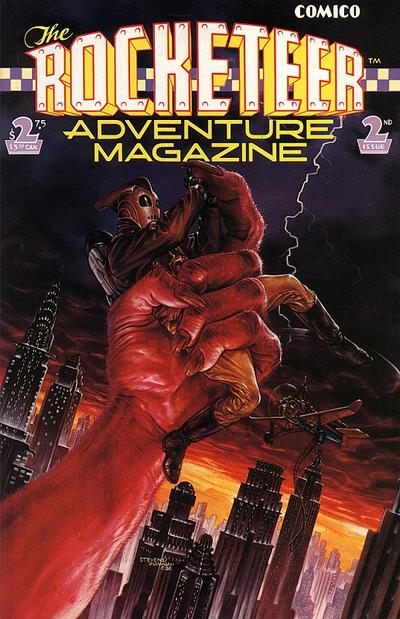
In some ways, it’s a real shame that Stevens was such a perfectionist of an artist. His reputation for taking an incredibly long time to complete almost anything to his own personal standards meant that all comic fans ever got from the artist were a handful of issues, covers and pinups during the late ‘80s and early ‘90s. Then again, the fact that Stevens took so much time and care with every picture he ever drew makes finding his work a complete thrill and a joy.
Like most folks, I first came across Stevens’ comics thanks to the film version of The Rocketeer that Disney released in 1991. The general rap on the film starring Billy Campbell and Jennifer Connelly is that despite a big marketing push from Disney and good reviews, the film failed to connect with audiences and had no real franchise potential. While I’m sure the box office receipts backed that position up, little Kiel Phegley would beg to differ.
After seeing “The Rocketeer,” I was Cliff Secord crazy. I spent that summer trying to stuff my backpack until it fit the appropriate aerodynamic shape and trying to glue a fin to the back of my baseball cap. On the merchandising end, I snatched up every piece of Rocketeer paraphernalia I could convince my mother to buy me from issues of Disney Adventures featuring cast interviews to water-powered rocket toys. But the crown jewel in my collection were Stevens’ original comics, which even during the film’s release were hard to find.
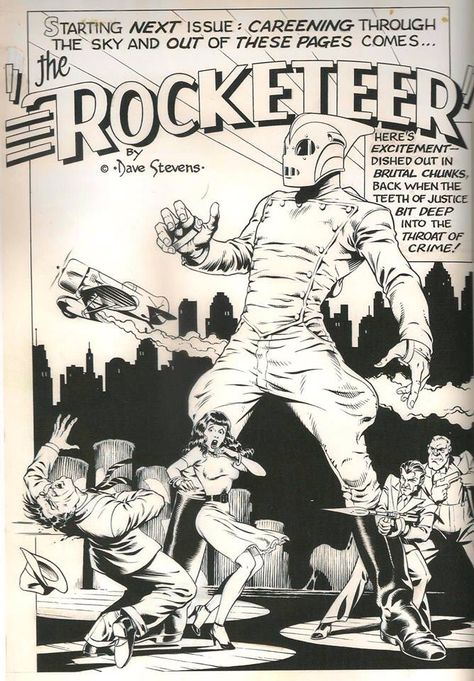
Published across four different comic companies and landing finally at Dark Horse, The Rocketeer comics are one of those rare instances where the art and story are somehow equally idealized and authentic. I’m sure LA airfields of the ‘40s were never as exciting and spy-filled as Stevens drew them and its women weren’t quite as glamorous either, but Stevens made you believe that America’s Golden Age of comics was also its Golden Age of style.
It took me the better part of five years to track down every installment of the original Rocketeer serial and even longer to meet Stevens. I have to admit, the brief meeting we had wasn’t the shining pillar of awesomeness you expect when you meet your artistic hero. I was 18 and at San Diego for the first time. When I realized Stevens had a table, I went straight there to shake the man’s hand and let him know that I owned every issue of The Rocketeer ever published. “Well, there were only like seven of them,” Stevens replied before I bought my Bulldog Studios T-shirt and shuffled along. I’m pretty sure that was the exact moment I realized that I wasn’t going to be seeing any more issues of the comic. Like so many of his artistic heroes of the Golden Age, Stevens never got enough credit or money from his creation to sustain a long term career in the funny book biz, instead earning his keep with illustration and pin-up work. Still, I’ve always been happy to have the few Stevens comics I could find on hand, and on a pure entertainment level, they remain my very favorites.
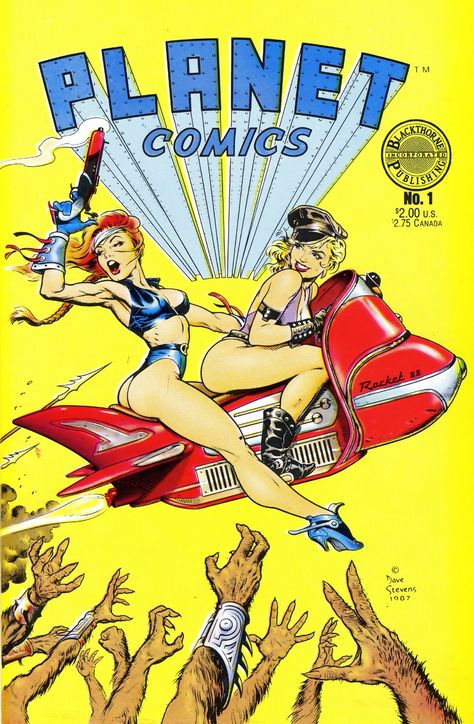
I was also lucky enough to make the acquaintance of Stevens friend and the star of “The Rocketeer” film, Billy Campbell in perhaps the nerdiest encounter of my entire life. In the summer of 2002, I was an editorial intern at DC Comics, and on a July afternoon when I was out to lunch, I spotted Campbell eating lunch at a deli around the corner from the offices. In what was either the stupidest or balliest moment of my life, I approached my boyhood hero to tell him how much of a fan I was and asked if it was true that as a kid he’d wanted to draw comic books instead of act (I’d read that somewhere in a magazine).
Campbell was an extremely cool guy and a big comic nerd, so I flipped out when he took me up on my offer to show him around the DC offices, which earned more than a few turned heads from staffers saying “Did the intern just bring in The Rocketeer off the street?” He told Mike Carlin and I about Stevens’ current life as Bettie Page’s caretaker (the artist based Secord’s girlfriend “Betty” off of the famed pin-up girl), and Carlin told us about an aborted Rocketeer/Superman crossover that would have been written by Stevens and featured Cliff teaching a ‘40s Clark Kent how to fly (how cool would that have been?).
After wandering around a bit and pointing out a few of his favorite Golden Age Batman covers, Campbell was nice enough to sign an autograph for me: “To Kiel – Thanks for the tour, dude! – Billy Campbell” I keep it in the back of my first Rocketeer trade along with a photo I snapped of the Bulldog Café set on the Disney Studio tour I went on in 4th grade and a handful of other small scraps of paper that remind me of how good Dave Stevens was at what he did.
If you get the chance, buy some of his comics. You won’t regret it.
Above is the cover to The Rocketeer Adventure Magazine#2, the first Dave Stevens comic I ever bought, the original art for the Rocketeer’s first appearance in Starslayer and the front to Planet Comics #1, which hangs above my desk here at Wizard. For more on Stevens, be sure to check out a remembrance over at The Beat.
